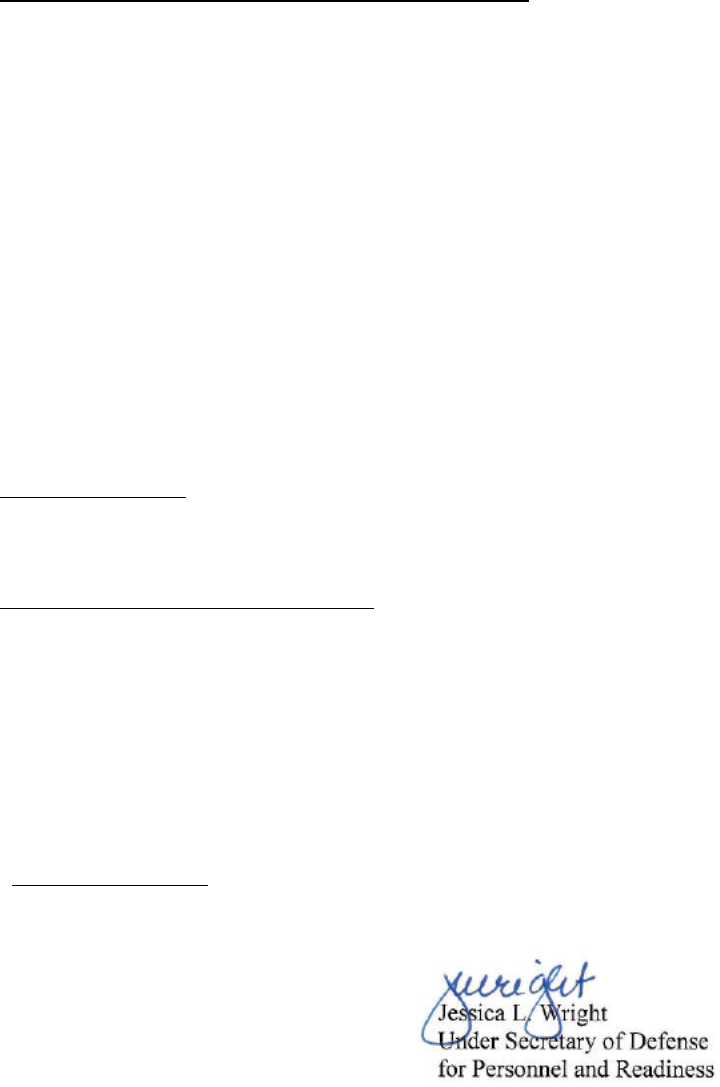
Department of Defense
INSTRUCTION
NUMBER 6060.02
August 5, 2014
Incorporating Change 2, Effective September 1, 2020
USD(P&R)
SUBJECT: Child Development Programs (CDPs)
References: See Enclosure 1
1. PURPOSE. This Instruction:
a. Reissues DoD Instruction (DoDI) 6060.2 (Reference (a)) in accordance with the authority
in DoD Directive (DoDD) 5124.02 (Reference (b)) and DoDI 1342.22 (Reference (c)) and the
requirements of DoDD 1020.1 (Reference (d)).
b. Updates established policy, assigns responsibilities, and prescribes procedures for
providing care to minor children (birth through age 12 years) of individuals who are eligible for
care in DoD CDPs. This includes:
(1) Center-based and community-based care.
(2) Family child care (FCC).
(3) School-age care (SAC).
(4) Supplemental child care.
c. Cancels DoDI 6060.3 (Reference (e)).
d. Implements sections 1791 through 1800 of title 10, United States Code (U.S.C.)
(Reference (f)).
e. Authorizes the publication of supporting guidance for the implementation of CDP policies
and responsibilities, including child development training modules, program aids, and other
management tools.
f. Establishes the DoD Effectiveness Rating and Improvement System (ERIS) in accordance
with sections 1791 to 1800 of Reference (f).

DoDI 6060.02, August 5, 2014
2
Change 2, 09/01/2020
2. APPLICABILITY. This Instruction applies to OSD, the Military Departments, the Office of
the Chairman of the Joint Chiefs of Staff and the Joint Staff, the Combatant Commands, the
Office of the Inspector General of the Department of Defense, the Defense Agencies, the DoD
Field Activities, and all other organizational entities within the DoD (hereinafter referred to
collectively as the “DoD Components”).
3. DEFINITIONS. See Glossary.
4. POLICY. In accordance with References (c) and (f), it is DoD policy to:
a. Ensure that the CDPs support the mission readiness, family readiness, retention, and
morale of the total force during peacetime, overseas contingency operations, periods of force
structure change, relocation of military units, base realignment and closure, and other emergency
situations (e.g., natural disasters and epidemics). Although child care supports working parents,
it is not an entitlement and parents must pay their share of the cost of child care.
b. Reduce the stress of families who have the primary responsibility for the health, safety
and well-being of their children and help them balance the competing demands of family life and
the DoD mission. CDPs provide access and referral to available, affordable, quality programs
and services that meet the basic needs of children, from birth through 12 years of age, in a safe,
healthy, and nurturing environment.
c. Conduct an annual internal certification process to ensure that all installation-operated
CDPs are operating in accordance with all applicable Federal mandates and statutory
requirements.
d. Provide child care to support the personnel and the mission of DoD. Eligibility is
contingent on the status of the sponsor.
(1) Eligible patrons include:
(a) Active duty military personnel.
(b) DoD civilian employees paid from either appropriated funds (APF) or non-
appropriated funds (NAF).
(c) Reserve Component military personnel on active duty or inactive duty training
status.
(d) Combat related wounded warriors.
(e) Surviving spouses of Military members who died from a combat related incident.

DoDI 6060.02, August 5, 2014
3
Change 2, 09/01/2020
(f) Those acting in loco parentis for the dependent child of an otherwise eligible
patron.
(g) Eligible employees of DoD contractors
(h) Others authorized on a space available basis
(2) In the case of unmarried, legally separated parents with joint custody, or divorced
parents with joint custody, children are eligible for child care only when they reside with the
Military Service member or eligible civilian sponsor at least 25 percent of the time in a month
that the child receives child care through a DoD program. There may be exceptions, as
addressed in Enclosure 3.
e. Promote the cognitive, social, emotional, cultural, language and physical development of
children through programs and services that recognize differences in children and encourage
self-confidence, curiosity, creativity, self-discipline, and resiliency.
f. Employ qualified direct program staff whose progression from entry level to positions of
greater responsibility is determined by training, education, experience, and competency. Ensure
that civilian employees maintain their achieved position and salary as they move within the
military child care system.
g. Certify qualified FCC providers who can support the mission requirements of the
installation.
h. Facilitate the availability and expansion of quality, affordable, child care off of military
installations that meet the standards of this Instruction to ensure that geographically dispersed
eligible families have access to legally operating military-approved community-based child care
programs.
i. Promote the early identification and reporting of alleged child abuse and neglect in DoD
CDPs in accordance with DoDI 6400.1 (Reference (g)).
j. Ensure that funding is available to meet Military Child Care Act requirements pursuant to
sections 1791 to 1800 of Reference (f) and protect the health, safety, and well-being of children
in care.
5. RESPONSIBILITIES. See Enclosure 2.
6. PROCEDURES. Enclosure 3 provides guidance for military operated or approved child
development centers (CDCs), FCC, and school-age programs.

DoDI 6060.02, August 5, 2014
4
Change 2, 09/01/2020
7. INFORMATION COLLECTIONS REQUIREMENTS
a. The DoD Child Development Program Annual Summary of Operations referred to in
paragraph 2.f. of Enclosure 2 of this instruction has been assigned report control symbol DD-
P&R(A)1884 in accordance with the procedures in Volume 1 of DoD Manual 8910.01
(Reference (h)).
b. DD Form 2652, “Application for Department of Defense Child Care Fees” referred to in
paragraph 7.b.(1)(a) of Enclosure 3 of this instruction has been assigned Office of Management
and Budget control number 0704-0515 in accordance with the procedures in Volume 2 of DoD
Manual 8910.01 (Reference (i)).
c. DD Form 2606, “Request for Care Record, Department of Defense Child Development
Program” referred to in paragraph 7.f. of Enclosure 3 of this instruction has been assigned Office
of Management and Budget control number 0704-0515 in accordance with the procedures in
Reference (i).
8. RELEASABILITY. Cleared for public release. This instruction is available on the
Directives Division Website at https://www.esd.whs.mil/DD.
9. SUMMARY OF CHANGES 1 AND 2. The changes to this issuance:
a. Change 1 updates references, definitions, and Section 1 of Enclosure 3 in accordance with
the February 21, 2020 Secretary of Defense Memorandum (Reference (j)).
b. Change 2 grants Coast Guard families the same access priority as their DoD counterparts
and postpones the June 1, 2020 effective date to September 1, 2020 in accordance with the
April 23, 2020 Secretary of Defense Memorandum (Reference (ab)).
10. EFFECTIVE DATE. This Instruction is effective August 5, 2014.
Enclosures
1. References
2. Responsibilities
3. Procedures
Glossary

DoDI 6060.02, August 5, 2014
5
Change 2, 09/01/2020
TABLE OF CONTENTS
ENCLOSURE 1: REFERENCES ...................................................................................................7
ENCLOSURE 2: RESPONSIBILITIES .........................................................................................9
ASSISTANT SECRETARY OF DEFENSE FOR READINESS AND FORCE
MANAGEMENT (ASD(R&FM) ........................................................................................9
DEPUTY ASSISTANT SECRETARY OF DEFENSE FOR MILITARY COMMUNITY
AND FAMILY POLICY (DASD(MC&FP)) ......................................................................9
HEADS OF THE DoD COMPONENTS ..................................................................................9
SECRETARIES OF THE MILITARY DEPARTMENTS......................................................12
INSTALLATION COMMANDERS .......................................................................................12
DIRECTORS OF THE DEFENSE AGENCIES AND DoD FIELD ACTIVITIES ...............13
ENCLOSURE 3: PROCEDURES ................................................................................................14
CHILDCARE REQUEST AND WAITLIST MANGEMENT ...............................................15
Request for Care. ..............................................................................................................15
Waitlist Management. .......................................................................................................15
Declining Care. .................................................................................................................15
PRIORITY SYSTEM ..............................................................................................................15
Priority 1. CDP Direct Care Staff, Service Members. ......................................................15
Priority 2. DoD Civilians. .................................................................................................16
Priority 3. Space Available. ..............................................................................................16
PRIORITY DETERMINATION. ...........................................................................................17
Deactivated Guard or Reserve Members. ..........................................................................17
Activated Coast Guard. .....................................................................................................17
Combat-Related Wounded Warriors in an Active Duty Status. .......................................17
Exceptions. ........................................................................................................................17
VERIFICATION REQUIREMENTS ......................................................................................17
NOTIFICATION TO PATRONS ............................................................................................18
TYPES OF CARE....................................................................................................................18
Military-Operated CDPs ....................................................................................................18
Military Department, Defense Agency, and DoD Field Activity-Approved Supplemental
Child Care Programs ....................................................................................................19
ADMINISTRATION, FUNDING, AND OVERSIGHT OF MILITARY-OPERATED
CDPs ..................................................................................................................................19
Background Checks ...........................................................................................................19
Funding ..............................................................................................................................19
Facility Requirements/Construction ..................................................................................21
Oversight ............................................................................................................................21
Parent Board.......................................................................................................................23
Enrollment..........................................................................................................................24
Immunizations....................................................................................................................24
DoDI 6060.02, August 5, 2014
6
Change 2, 09/01/2020
Child Abuse Prevention and Reporting .............................................................................25
Programming and Standards of Operation .........................................................................25
PERSONNEL ..........................................................................................................................25
CDC Directors ...................................................................................................................26
SAC Directors ....................................................................................................................26
Training and Curriculum Specialists .................................................................................26
FCC Administrators ...........................................................................................................26
CDP Direct Care Personnel, Support Staff, and FCC Providers .......................................27
TRAINING ..............................................................................................................................27
CDP Management Personnel .............................................................................................27
Training and Curriculum Specialists ................................................................................27
CDP Direct Care Personnel and FCC Providers ................................................................28
CDP Support Staff .............................................................................................................29
VOLUNTEERS .......................................................................................................................29
SUPPLEMENTAL CHILD CARE..........................................................................................30
ADMINISTRATION AND OVERSIGHT OF COMMUNITY-BASED CARE
PROVIDERS .....................................................................................................................30
Types of Care .....................................................................................................................30
Subsidies ............................................................................................................................31
AUGMENTED PROGRAM SUPPORT .................................................................................32
CDC AND SAC STANDARDS OF OPERATION, FCC STANDARDS OF
OPERATION, AND THE ERIS ........................................................................................32
GLOSSARY ..................................................................................................................................59
PART 1: ABBREVIATIONS AND ACRONYMS ................................................................58
PART 2: DEFINITIONS ........................................................................................................60
TABLES
1. CDC and School-Age Programs Standards of Operations .................................................33
2. FCC Standards of Operation ..............................................................................................45
3. ERIS ....................................................................................................................................50

DoDI 6060.02, August 5, 2014
7
Change 2, 09/01/2020 ENCLOSURE 1
ENCLOSURE 1
REFERENCES
(a) DoD Instruction 6060.2, “Child Development Programs (CDPs),” January 19, 1993, as
amended (hereby cancelled)
(b) DoD Directive 5124.02, “Under Secretary of Defense for Personnel and Readiness (USD
(P&R)),” June 23, 2008
(c) DoD Instruction 1342.22, “Military Family Readiness,” July 3, 2012, as amended
(d) DoD Directive 1020.1, “Nondiscrimination on the Basis of Handicap in Programs and
Activities Assisted or Conducted by the Department of Defense,” March 31, 1982, as
amended
(e) DoD Instruction 6060.3, “School-Age Care (SAC) Program,” December 19, 1996 (hereby
cancelled)
(f) Sections 1783, 1791 through 1800, 2809, and 2812 of title 10, United States Code
(g) DoD Instruction 6400.1, “Family Advocacy Program (FAP),” May 1, 2019
(h) DoD Manual 8910.01, Volume 1, “DoD Information Collections: Procedures for DoD
Internal Information Collections,” June 30, 2014, as amended
(i) DoD Manual 8910.01, Volume 2, “DoD Information Collections: Procedures for DoD
Public Information Collections,” June 30, 2014
(j) Secretary of Defense Memorandum, “Policy Change Concerning Priorities for Department
of Defense Child Care Programs,” February 21, 2020
(k) DoD Instruction 1402.05, “Background Checks on Individuals in DoD Child Care Services
Programs,” September 11, 2015, as amended
(l) DoD Instruction 5305.5, “Space Management Procedures for the National Capital Region
(NCR),” November 4, 2015
(m) Section 590 of title 40, United States Code
(n) Section 30125 of title 49, United States Code
(o) Sections 21 (a), 21 (b), 61,129 and 134 of title 26, United States Code (also known as “The
Internal Revenue Code,” as amended)
(p) DoD Instruction 1400.25, Volume 1405, “DoD Civilian Personnel Management System:
Nonappropriated Fund (NAF) Pay, Awards, and Allowances,” June 26, 2014
(q) Unified Facilities Criteria 4-740-14, “Design: Child Development Centers,” August 1, 2002
(r) Department of the Army, Assistant Chief of Staff for Installation Management,
Memorandum, “Army Standard for Child Development Center,” October, 2004
(s) Unified Facilities Criteria 4-740-06, “Youth Centers,” January 12, 2006
(t) National Fire Protection Association 101, “Life Safety Code,” 2012
(u) AR 40–562/BUMEDINST 6230.15A/AFJI 48–110/CG COMDTINST M6230.4F,
“Immunizations and Chemoprophylaxis,” September 29, 2006
(v) DoD Instruction 1100.21, “Voluntary Services in the Department of Defense,” March 11,
2002, as amended
(w) Part 226 of title 7, Code of Federal Regulations
(x) DoD Instruction 1015.15, “Establishment, Management and Control of Nonappropriated
Fund Instrumentalities and Financial Management of Supporting Resources,” October 31,
2007, as amended
(y) Parts 56 and 238.3 of title 32, Code of Federal Regulations
DoDI 6060.02, August 5, 2014
8
Change 2, 09/01/2020 ENCLOSURE 1
(z) Section 705 of title 29, United States Code (also known as “Section 7 of The Rehabilitation
Act of 1973,” as amended)
(aa) Section 12102 of title 42, United States Code (also known as “The Americans with
Disabilities Act of 1990,” as amended)
(ab) Secretary of Defense Memorandum, “Update to Child Care Policy Change Dated February
21, 2020,” April 23, 2020

DoDI 6060.02, August 5, 2014
9
Change 2, 09/01/2020 ENCLOSURE 2
ENCLOSURE 2
RESPONSIBILITIES
1. ASSISTANT SECRETARY OF DEFENSE FOR READINESS AND FORCE
MANAGEMENT (ASD(R&FM)). The ASD(R&FM), under the authority, direction, and control
of the USD(P&R), shall:
a. Monitor compliance with this Instruction by personnel under his or her authority,
direction, and control.
b. Annually review and issue a child care fee policy based upon total family income (TFI)
for use by programs in the DoD child development system of care.
2. DEPUTY ASSISTANT SECRETARY OF DEFENSE FOR MILITARY COMMUNITY
AND FAMILY POLICY (DASD(MC&FP)). The DASD(MC&FP), under the authority,
direction, and control of the ASD(R&FM), shall:
a. Work across functional areas of responsibility and collaborate with other Federal and non-
governmental organizations to ensure access to a continuum of quality, affordable CDPs.
b. Program, budget, and allocate funds and other resources to meet the objectives of this
Instruction.
c. Issue DD Form 2636, “Child Development Program, Department of Defense Certificate to
Operate,” to the Military Departments for each CDP found to be in compliance with this
Instruction.
d. Require that the policies and related documents are updated and relevant to the program.
e. Report DoD Component program data to support legislative, research, and other
requirements.
3. HEADS OF THE DoD COMPONENTS. The Heads of the DoD Components shall:
a. Establish implementing guidance and ensure full implementation within 12 months of the
publication date, consistent with this Instruction, monitor compliance through regular inspection
of CDPs and follow-up oversight actions as needed.
b. Program, budget, and allocate funds and other resources to meet the requirements of this
Instruction.
c. Establish a priority system for all patrons seeking to enroll children in CDPs in
accordance with section 1 of Enclosure 3.
DoDI 6060.02, August 5, 2014
10
Change 2, 09/01/2020 ENCLOSURE 2
d. Assess DoD Component demand and take appropriate action to address the child care
capability needed on and off the installation in accordance with sections 11 and 12 of Enclosure
3.
e. Establish a hardship waiver policy to address financial and operational situations.
f. Submit fiscal year annual summary of operations reports to the DASD(MC&FP) by
December 30 of each year using report control symbol DD-P&R(A)1884, “Department of
Defense Child Development Program (CDP) Annual Summary of Operations.”
g. Require that background checks are conducted for individuals who have contact with
children in DoD CDPs in accordance with DoDI 1402.05 (Reference (k)) and section 7.a of
Enclosure 3.
h. Require that all individuals who have contact with children in a DoD CDP complete a DD
Form 2981 “Basic Criminal History and Statement of Admission”.
i. Require that each CDP establishes a Parent Board in accordance with section 1783 and
1795 of Reference (f).
j. Forward the results of DoD Component inspections to the DASD (MC&FP).
k. Ensure that all incidents that occur within a DoD CDP and involve allegations of child
abuse or neglect, revocation of accreditation, or hospitalization of a child, are reported to DASD
(MC&FP) through the Office of Family Policy (OFP/CY) within 72 hours of the incident.
l. Notify the DASD (MC&FP) through OFP/CY if, at any time, a facility in the CDP is
closed due to a violation (see section 7.d (2) of Enclosure 3, for more information on violations).
m. Provide the DASD (MC&FP) though OFP/CY with a copy of applications made in
accordance with DoDI 5305.5 (Reference (l)) and section 590 of title 40, U.S.C. (Reference (m))
to the U.S. General Services Administration (GSA) for building space for use in providing child
care for DoD personnel, and comply with GSA standards for funding and operation of child care
programs in GSA-controlled space.
(1) Where the DoD is the sole sponsoring agency and the space has been delegated to the
DoD by the GSA, the space must comply with the requirements prescribed in this Instruction.
(2) For the National Capital Region, space acquisition procedures in Reference (l) shall
be used to gain the assignment of space in Government-owned or Government-leased facilities
from the GSA.
n. Require that CDPs follow the recommendations of the Advisory Committee on
Immunization Practices (ACIP) and comply with generally accepted practices endorsed by the
American Academy of Pediatrics (AAP) and Centers for Disease Control or the latest guidance
provided by OFP/OCY.
DoDI 6060.02, August 5, 2014
11
Change 2, 09/01/2020 ENCLOSURE 2
o. Establish and implement DoD Component-specific child care fees based on the DoD-
issued fee policy on an annual basis, and issue supplemental guidance on fees for school-age
programs, hourly care, preschool programs, DoD Component approved community-based
programs, and FCC subsidies. Submit DoD Component specific requests for waiver for any
deviation from DoD policy, including selection of the high or low cost fee option, to the Office
of the DASD(MC&FP) through OFP/CY for approval.
p. Establish guidelines for communication between command, installation, and educational
and behavioral support systems.
q. Require that all military installations under their authority follow guidance that addresses
the ages and circumstances under which a child under 13 years of age can be left at home alone
without adult supervision, also known as a “home alone policy,” or “self-care policy.” The
installation commander should approve this policy in consultation with the installation director
of the Family Advocacy Program. Guidance is consistent with or more stringent than applicable
laws and ordinances of the State and country in which the installations are located.
r. Establish guidance and operating procedures to provide services for children with special
needs in accordance with References (d) and part 56 of title 32, Code of Federal Regulations
(Reference (y)) as they apply to children and youth with special needs.
(1) Require procedures for reviewing and making reasonable accommodation for
children with special needs that do not fundamentally alter the nature of the program.
(2) Consider the needs of the child, the disability, and the environment of group care in
child development facilities or home-based care, staffing needs and training requirements, and
the resources of the program.
(3) Include CDPs as part of the Multidisciplinary Inclusion Action Team that supports
families of children with special needs.
s. Establish guidance and operating procedures to provide services for children of the
deployed.
t. Establish standard risk management procedures for responding to emergency or
contingency situations. This includes, but is not limited to, natural disasters, pandemic disease
outbreaks, allegations of child abuse or neglect, active shooter, or an installation or facility
lockdown.
u. Require that vehicles used to transport children comply with Federal motor vehicle safety
standards in accordance with section 30125 of title 49, U.S.C. (Reference (n)) and applicable
State or host nation requirements.
v. Notify applicable civilian patrons annually of their potential tax liability associated with
child care subsidies, and ensure that information required by the third party administrator (TPA)
is provided in accordance with section 129 of title 26, U.S.C. (Reference (o)).

DoDI 6060.02, August 5, 2014
12
Change 2, 09/01/2020 ENCLOSURE 2
w. Require that a current plan to implement direct cash subsidies to military-approved child
care providers to expand the availability of child care spaces and meet specialized child care
needs, such as weekend and evening care, special needs, deployment support, and respite child
care support, is in place.
4. SECRETARIES OF THE MILITARY DEPARTMENTS. The Secretaries of the Military
Departments, in addition to the responsibilities in section 3 of this enclosure, shall:
a. Work with the Heads of the DoD Components to implement CDPs in accordance with this
Instruction.
b. Notify the OFP/CY of any Service-wide specific requirements that will require a waiver
to deviate from existing policy.
5. INSTALLATION COMMANDERS. The installation commanders (under the authority,
direction, and control of the Secretary of the Military Department concerned) shall:
a. Require that CDPs within his or her jurisdiction are in compliance with this Instruction.
b. Require that child care fees are used in accordance with Reference (l) and 7.b of
Enclosure 3.
c. Require that CDP direct program staff are paid in accordance with Volume 1405 of DoDI
1400.25 (Reference (p)). Ensure 75 percent of the program’s direct program staff total labor
hours are paid to direct program staff who are in benefit status.
d. Require that there are adequate numbers of qualified professional staff to manage the
CDPs according to the Service manpower and child space staffing requirements and referenced
in sections 7 and 8 of Enclosure 3 of this Instruction.
e. Manage child care priority policy, as directed by their respective DoD Component.
f. Manage hardship waiver policy (financial and operational), as directed by their respective
DoD Component.
g. Review and validate the demand for installation child care capacity and take appropriate
action to expand the availability of care as needed. See section 12 of Enclosure 3 of this
Instruction.
h. Convene a Parent Board, and require that a viable Parent Participation Program is in
accordance with sections 1783 and 1795 of Reference (f).
i. Implement mandated annual and periodic inspections and complete required corrective
and follow-up actions within timeframes specified by their respective DoD Component.

DoDI 6060.02, August 5, 2014
13
Change 2, 09/01/2020 ENCLOSURE 2
6. DIRECTORS OF THE DEFENSE AGENCIES AND DoD FIELD ACTIVITIES. In addition
to the responsibilities in Section 3 of this enclosure, the Directors of the Defense Agencies and
DoD Field Activities shall:
a. Require that CDPs within his or her jurisdiction are in compliance with this Instruction.
b. Require that child care fees are used in accordance with Reference (l) and 7.b of
Enclosure 3.
c. Require that CDP direct program staff are paid in accordance with Reference (p). Ensure
75 percent of the program’s direct program staff total labor hours are paid to direct program staff
who are in benefit status.
d. Require that there are adequate numbers of qualified professional staff to manage the
CDPs according to the Service manpower and child space staffing requirements and referenced
in sections 7 and 8 of Enclosure 3 of this Instruction.
e. Manage child care priority policy, as directed by their respective DoD Component.
f. Manage hardship waiver policy (financial and operational), as directed by their respective
DoD Component.
g. Review and validate the demand for installation child care capacity and take appropriate
action to expand the availability of care, as needed. See section 12 of Enclosure 3 of this
Instruction.
h. Convene a Parent Board, and require that a viable Parent Participation Program is in
accordance with sections 1783 and 1795 of Reference (f).
i. Implement mandated annual and periodic inspections and complete required corrective
and follow-up actions within timeframes specified by their respective DoD Component.

DoDI 6060.02, August 5, 2014
14
Change 2, 09/01/2020 ENCLOSURE 3
ENCLOSURE 3
PROCEDURES
1. CHILD CARE REQUEST AND WAITLIST MANAGEMENT
a. Request for Care. Families will apply for and request child care through
MilitaryChildCare.com (MCC) for all military-operated child care.
b. Waitlist Management. Installation CDPs will utilize MCC as the method to manage child
care spaces, active care options, and offerings.
c. Declining Care. In the event that a family declines care at an installation where they have
requested care through MCC, they will be removed from all current waitlists and must re-request
care through MCC.
2. PRIORITY SYSTEM. Priority for care is administered by MCC based on the eligibility
requirements defined in paragraph 4.d. of the front matter of this instruction. Individual priority
is verified at the time of enrollment and annually thereafter.
a. Priority 1. CDP Direct Care Staff, Service Members. The children of CDP Direct Care
Staff and Service members will be placed into care utilizing the following guidance:
(1) Priority 1A. CDP Direct Care Staff. The children of Direct Care CDP staff will be
placed into care ahead of all other eligible patrons. At no time will the child of a Direct Care
CDP staff member be removed from the program to accommodate another eligible patron.
(2) Priority 1B. Single or Dual Active Duty Members; Single or Dual Guard or Reserve
Members on Active Duty or Inactive Duty Training Status; and Service Members With a Full-
time Working Spouse. The children of patrons that fall under Priority 1B will be placed into care
ahead of all other eligible patrons except Priority 1A. At no time will a Priority 1B patron be
removed from the program to accommodate any other patron, including 1A patrons. The
following order of precedence will be utilized:
(a) Single or Dual Active Duty members.
(b) Single or Dual Guard or Reserve Members on Active Duty or Inactive Duty
training status.
(c) Active Duty with a full-time working spouse.
(d) Guard or Reserve Members on Active Duty or Inactive Duty training status with
a full-time working spouse.

DoDI 6060.02, August 5, 2014
15
Change 2, 09/01/2020 ENCLOSURE 3
(3) Priority 1C. Active Duty Members or Guard or Reserve Members on Active Duty or
Inactive Duty Training Status with Part-Time Working Spouse or a Spouse Seeking
Employment. The children of patrons that fall under Priority 1C will be placed into care ahead
of all other eligible patrons except for Priority 1A and 1B patrons. Priority 1C patrons may only
be supplanted by an eligible patron in Priority 1A or 1B when the Anticipated Placement Time of
the Priority 1A and 1B patron exceeds 45 days beyond their Date Care Needed (as indicated in
MCC). The following order of precedence will be utilized:
(a) Active Duty members with a part-time working spouse or a spouse seeking
employment.
(b) Guard or Reserve Members on Active Duty or Inactive Duty training status with
a par-time working spouse or a spouse seeking employment.
(4) Priority 1D. Active Duty Members or Guard or Reserve Members on Active Duty or
Inactive Duty Training Status with a Spouse Enrolled in a Post-Secondary Institution on a Full-
Time Basis. The children of patrons that fall under Priority 1D will be placed into care ahead of
all other eligible patrons except for Priority 1A, 1B, and 1C patrons. Priority 1D patrons will be
supplanted by an eligible patron in Priority 1A, 1B, or 1C when the Anticipated Placement Time
of the Priority 1A, 1B, and 1C patron exceeds 45 days beyond their Date Care Needed (as
indicated in MCC). The following order of precedence will be utilized:
(a) Active Duty members with a spouse enrolled in a post-secondary institution on a
full-time basis.
(b) Guard or Reserve Members on Active Duty or Inactive Duty training status with
a spouse enrolled in a post-secondary institution on a full-time basis.
b. Priority 2. DoD Civilians. The children of DoD civilians will be placed into care
utilizing the following guidance:
(1) Patrons in Priority 2 will utilize the following order of precedence for placement:
(a) Single or dual DoD Civilian Employees.
(b) DoD Civilian Employees with a full-time working spouse.
(2) DoD civilian patrons may only be supplanted from care by an eligible Priority 1A or
1B patron when the Anticipated Placement Time of the Priority 1A or 1B patron exceeds 45 days
beyond their Date Care Needed (as indicated in MCC).
c. Priority 3. Space Available. When all Priority 1 and 2 patrons have been placed into care,
CDPs may place additional eligible patrons not identified in Priority 1 and 2 into Space
Available care.

DoDI 6060.02, August 5, 2014
16
Change 2, 09/01/2020 ENCLOSURE 3
(1) Space Available patrons will be supplanted, within 45 days’ written notice, by an
eligible Priority 1 or a Priority 2 patron when the Anticipated Placement Time of the Priority 1 or
a Priority 2 patron exceeds 45 days beyond their Date Care Needed (as indicated in MCC).
(2) The following order of precedence will be followed when placing eligible patrons
into Space Available.
(a) Active Duty with non-working spouse.
(b) DoD Civilian Employees with spouse seeking employment.
(c) DoD Civilian Employees with a spouse enrolled in a post-secondary educational
program on a full time basis.
(d) Gold Star spouses.
(e) DoD contractors.
(g) Other eligible patrons.
3. PRIORITY DETERMINATION. The following factors will be applied when making priority
determinations for eligible patrons.
a. Deactivated Guard or Reserve Members. When a currently enrolled Guard or Reserve
member is no longer in an Active Duty status, they must inform the appropriate CDP. The CDP
will make a new priority determination for possible continued enrollment. If the member falls to
a lower priority category and the child care space is needed for a higher priority patron, the
Guard or Reserve member will be given 45 days' written notice regarding their removal from the
program.
b. U.S. Coast Guard. For the purpose of this instruction, Coast Guard Service members
(Active Duty and Reserve Component) and civilian employees will hold the same priority as
equivalent DoD Service members and civilian employees, as detailed above, regardless of the
Department in which the Coast Guard is operating.
c. Combat-Related Wounded Warriors in an Active Duty Status. When Service members
designated as combat-related wounded warrior in an Active Duty status requires hospitalization,
extensive rehabilitation, or significant care from a spouse or care provider and requires full-time
child care, they may be placed into Priority 1B. This designation requires installation commander
approval (this authority cannot be delegated).
d. Exceptions. Exceptions to the priority system described in this enclosure will only be
authorized, in writing, for unique mission-related requirements. Authority for these exceptions
lies with the installation commander responsible for the management of the CDP at the
installation level.

DoDI 6060.02, August 5, 2014
17
Change 2, 09/01/2020 ENCLOSURE 3
4. VERIFICATION REQUIREMENTS. The following methods will be utilized to determine
eligibility:
a. A working spouse must provide verification of employment such as a Pay/Leave and
Earning Statement, Form 1099-MISC, Schedule C (Form 1040 or 1040 SR), or a self-
certification statement with an estimated number of hours worked on a weekly or monthly basis.
In the event that specific employment situations are not sufficiently documented by these forms,
an exception to policy may be granted at the installation commander level.
b. Spouses actively seeking employment must submit verification every 30 days once the
child is enrolled in care. The child may be removed from care if the spouse has not gained
employment after 90 days. The installation commander may authorize an extension of care
beyond 90 days as long as higher priority patrons are not impacted.
c. Spouses enrolled in a post-secondary educational program on a full time basis must verify
educational admission or enrollment as a full time student every 90 days once the patron is
enrolled in care. If, at the time of verification, the spouse is not currently enrolled, they must
show proof of resumption of full time student status within 30 days or the child may be removed
from care.
5. NOTIFICATION TO PATRONS. At the time of enrollment, CDPs must notify patrons in
Priority 1C and lower, in writing, that they may be supplanted if a patron in a higher priority
requires child care. The CDP must also provide notice of discontinued child care to patrons
affected a minimum of 45 days before child care termination.
6. TYPES OF CARE. The types of care offered for children from birth through 12 years of age
include 24/7 care and care provided on a full-day, part-day, short-term, or intermittent basis.
a. Military-Operated CDPs. Military-operated (on and off installation) CDPs generally
include:
(1) CDCs. Reference Table 1 of Enclosure 3 of this Instruction for standards of
operation for CDCs. CDCs primarily offer care to children from birth to 5 years of age, but may
also be used to provide SAC programs.
(2) SAC Programs. Reference Table 1 of Enclosure 3 for SAC standards of operation.
SAC programs primarily offer care to children from 6 to 12 years of age. Care may be offered in
CDCs and other installation facilities, such as youth centers and schools.
(3) FCC. Reference Table 2 of Enclosure 3 for FCC standards of operation. Child care
services are available to children from infancy through 12 years of age and are provided in
government housing or in state licensed/regulated homes in the community.
(4) Supplemental Child Care. Services include short-term alternative child care options
in approved settings on and off installation.

DoDI 6060.02, August 5, 2014
18
Change 2, 09/01/2020 ENCLOSURE 3
(5) Part-Day and Hourly Programs. CDP space used for part-day and hourly programs,
including programs to provide respite child care, shall not exceed 20 percent of the CDP
program’s capacity during duty hours.
b. Military Department, Defense Agency, and DoD Field Activity-Approved Supplemental
Child Care Programs. See section 11 of this enclosure.
7. ADMINISTRATION, FUNDING, AND OVERSIGHT OF MILITARY-OPERATED CDPs.
Unless otherwise noted, the requirements in this section apply to all DoD-operated CDPs.
a. Background Checks. All background checks for individuals who have regular, recurring
contact with children and youth in CDPs, including adult family members of FCC providers and
any individual over the age of 18 living in a home where child care is provided, and persons who
serve as substitute or backup providers, shall be conducted in accordance with Reference (k).
b. Funding. CDPs are funded by a combination of APF and NAF.
(1) The amount of APF used to operate CDPs shall be no less than the amount collected
through child care fees, except for CDCs that operate under a long-term facility’s contract or
lease-purchase agreement under sections 2809 and 2812 of Reference (f).
(a) A family’s child care fee category is determined based on an initial and
subsequent annual verification of TFI. Families pay the child care fee assigned to that TFI
category. A family’s fees may only be adjusted once per year, with exceptions listed in
paragraph 7.b.(1)(e) of this enclosure. TFI is determined utilizing DD Form 2652.
(b) APF may be used to subsidize child care in military-approved civilian programs
in accordance with Reference (f).
(c) DoD Components establishing child care fee assistance programs for their
employees must contribute the amounts required to pay subsidies out of agency APFs.
(d) FCC providers are private contractors. Fees are established between the provider
and parent, unless such providers receive direct monetary subsidies. When FCC providers
receive direct monetary subsidies to reduce the cost of care for the families they service, the
installation commander or DoD Component shall determine relevant fees charged by FCC
providers.
(e) Fees may be adjusted:
1. By the installation commander, Defense Agency Director, or DoD Field
Activity Director:

DoDI 6060.02, August 5, 2014
19
Change 2, 09/01/2020 ENCLOSURE 3
a. On a case-by-case basis for families who are facing financial hardship or
unusual circumstances that merit review, in accordance with established DoD Component
guidance.
b. For parents participating in an approved parent participation program.
2. By the DoD Components, Defense Agency Director or DoD Field Activity
Director:
a. To accommodate an optional high market rate when it is necessary to pay
higher wages to compete with local labor or at those installations where wages are affected by
non-foreign area cost of living allowance (COLA), post differential or locality pay. The optional
low market rate may be used in areas where costs for comparable care within the installation
catchment area are significantly lower. A request to utilize the high or low market rate options
must be submitted to OFP/OCY for approval.
b. To reflect changes in employment status, relocation, and in the case of
annual internal reviews that find inaccurate determination or calculation of TFI.
c. For CDP employees when CDC programs are facing operational hardships.
(2) Child Development Program Element APF may be used for:
(a) Salaries of CDP employees.
(b) Food.
(c) Training and education.
(d) Program accreditation fees and support services.
(e) Travel and transportation.
(f) Marketing, to include recruitment, retention, and participation efforts.
(g) Supplies and equipment, to include lending libraries and training materials for use
by FCC providers.
(h) Local travel expenses incurred by FCC program staff using their private vehicles
to perform government functions.
(i) Direct monetary subsidies to FCC providers.
(3) To the maximum extent possible, child care fees shall cover the NAF cost of care,
and NAF costs not covered by child care fees are to be minimized. Child care fees shall only be
used for:

DoDI 6060.02, August 5, 2014
20
Change 2, 09/01/2020 ENCLOSURE 3
(a) Compensation of direct care CDP employees who are classified as NAF
employees, to include training and education, and recruitment and retention initiatives approved
by the DoD Component.
(b) Food-related expenses not paid by the USDA or DoD APFs.
(c) Consumable supplies.
c. Facility Requirements and Construction
(1) Minimum prescribed construction standards:
(a) For all Marine Corps, Navy, and Air Force CDC facility construction, the Unified
Facilities Criteria (UFC) 4-740-14 (Reference (q)) apply.
(b) For all Army CDC facility construction, the Army Standard for Child
Development Centers (Reference (r)) apply.
(c) When SAC is provided in youth facilities, UFC 4-740-06 (Reference (s)) and
Service-specific exceptions to the UFC apply.
(d) State and local construction standards may be used but are not required, except if
the CDC facility is located on an area over which the United States has no legislative
jurisdiction, and then only if State and local standards are more stringent than those in Reference
(n).
(2) All facilities shall comply with the structural requirements of the National Fire
Protection Association 101, “Life Safety Code®” (Reference (t)).
d. Oversight
(1) DoD Certification Inspection. Installation-operated CDPs in which care is provided
for 10 or more child care hours per week on a regular basis shall be certified to operate through
inspections occurring no fewer than four (4) times a year. Inspections must be unannounced, and
parent and staff feedback shall be solicited as part of the inspection process.
(a) Three local inspections and one higher headquarters inspection shall be conducted
to verify compliance with this Instruction and DoD Component implementing guidance. Local
inspection teams are led by a representative of the installation commander, Defense Agency
Director, or Defense Field Activity Director, and a multidisciplinary team, to include human
resource, fire, health, and safety proponents, with expertise and authority to verify compliance
with this Instruction.
1. Local inspections include an annual comprehensive health and sanitation
inspections, annual comprehensive fire and safety inspections, and a multidisciplinary inspection

DoDI 6060.02, August 5, 2014
21
Change 2, 09/01/2020 ENCLOSURE 3
whose team that includes parent representation. Community representation on the team by
appropriate professionals is highly encouraged.
2. DoD Component inspection teams inspecting CDPs serving children birth
through 12 years of age shall include staff possessing:
a. A baccalaureate degree in child development, early childhood education
(ECE), home economics (early childhood emphasis), elementary education, special education, or
other degree appropriate to the position filled from an accredited college;
b. Knowledge of child and youth development programs; or
c. A combination of education and experience that provide knowledge
comparable to that normally acquired through the successful completion of a 4-year degree
(experience must include at least 3 years of full-time teaching or management experience with
children of the appropriate age group).
3. Parents shall be interviewed as part of the DoD Component inspection.
Additional inspections shall be conducted in response to program complaints in accordance with
section 2 of Enclosure 2.
4. Results of DoD Component inspections shall be provided by the DoD
Component to the ODASD(MC&FP) through OFP/CY. CDPs whose inspection results
demonstrate compliance with this Instruction shall receive DD Form 2636. Certificates shall be
displayed in a prominent location in the CDP.
5. Inspection results shall be made available to parents. Results from inspections
of CDC programs shall be available online.
6. Periodic, unannounced inspections shall be made by the ODASD(MC&FP) to
ensure compliance with the requirements in this Instruction.
7. In response to each inspection, a corrective action plan with appropriate
timelines shall be developed to address any deficiencies identified during inspection.
(2) Violations. The installation commander, Defense Agency Director or DoD Field
Activity Director shall ensure the immediate remedy of any life-threatening violation of this
Instruction or other safety, health, and child welfare laws or regulations (discovered at an
inspection or otherwise) at a DoD CDP, or he or she will close the facility (or affected parts of
the facility).
1. In the case of a violation that is not life-threatening, the commander of the
major command under which the installation concerned operates, or the Director of the Defense
Agency or DoD Field Activity concerned, may waive the requirement that the violation be
remedied immediately for up to 90 days beginning on the date of discovery of the violation.

DoDI 6060.02, August 5, 2014
22
Change 2, 09/01/2020 ENCLOSURE 3
2. If the violation that is not life-threatening is not remedied by the end of that
90-day period, the facility or parts involved will be closed until the violation is remedied.
3. The Secretary of the Military Department or Director of the Defense Agency
or DoD Field Activity concerned, may request a waiver of the requirements of the preceding
sentence to authorize the program to remain open in a case where the violation cannot reasonably
be remedied within the 90-day period or in which major facility reconstruction is required. A
waiver request must be submitted to OFP/OCY for approval.
(3) Accreditation. Eligible CDP facilities (excluding FCC) shall be accredited by a
DoD-approved national accrediting body. CDP oversight is a statutory requirement involving an
external nationally recognized accreditation process and internal DoD Certification process.
(a) FCC providers shall be encouraged to seek accreditation from an appropriate
national accrediting body.
(b) The percentage of CDP facilities successfully achieving accreditation shall be
reflected in the Annual Summary of Operations report referenced in Enclosure 2.
(4) Monitoring. There shall be a system in place to monitor FCC homes on a regular
basis during all hours of operation. The following information shall be maintained for FCC
providers:
(a) Results of family interview.
(b) Background check with suitability determination.
(c) Inspection results.
(d) Insurance.
(e) Training records.
(f) Monitoring visit records.
e. Parent Board. In accordance with sections 1783 and 1795 of Reference (f), each CDP
shall establish a Parent Board to discuss problems and concerns and to provide recommendations
for improving CDPs. The Board, with the staff of the program, is responsible for coordinating a
parent participation program.
(1) The Board shall be composed only of parents of children enrolled in the installation
CDP facilities that are Military Service members, retired Military Service members, or spouses
of Military Service members or retired Military Service members, and chaired by such a parent.
(2) The Board shall meet periodically with the staff of the program and the installation
commander, Defense Agency Director, or DoD Field Activity Director to discuss problems and
concerns. Board recommendations shall be forwarded to the installation commander Defense

DoDI 6060.02, August 5, 2014
23
Change 2, 09/01/2020 ENCLOSURE 3
Agency Director, or DoD Field Activity Director review and disposition. These
recommendations are reviewed during the DoD certification inspection.
(3) The Board shall coordinate a parent participation program with CDP staff to ensure
parents are involved in CDP planning and evaluation. In accordance with Reference (f), parents
participating in such program may be eligible for child care fees at a rate lower than the rate that
otherwise applies.
f. Enrollment. To enroll in the CDP, parents shall complete DD Form 2606 or electronic
equivalent, DoD Child Development Program Request for Care Record. At the time of
enrollment in an installation-based CDP, parents shall provide:
(1) Child(ren)’s health and emergency contact information.
(2) Documentation that children have been fully immunized.
(a) Children who have not received their age-appropriate immunizations prior to
enrollment and do not have a documented religious or medical exemption from routine
childhood immunizations shall show evidence of an appointment for immunizations; the
immunization series must be initiated within 30 days.
(b) Children in SAC are not required to provide documentation if they are enrolled in
a local public school system where proof of currency of vaccination is required.
(3) Children’s records shall be updated annually or as needed for their health, safety, or
well-being.
g. Immunizations. Children enrolling in or currently enrolled in DoD CDPs must provide
written documentation of immunizations appropriate for the child’s age. Per AR 40-
562/BUMEDINST 6230.15A/AFJI 48-110/CG COMDTINST M6230.4F (Reference (u)),
immunizations recommended by the ACIP are required.
(1) All records shall be updated at least annually and kept on file. Any child not enrolled
in a school system where proof of currency of vaccination is required must provide proof of
currency.
(2) Children enrolled in a local public school system and volunteer sports coaches are
excluded from this requirement.
(3) A waiver for an immunization exemption may be granted for medical or religious
reasons. Philosophical exemptions are not permitted. The DoD Component must provide
guidance on the waiver process.
(a) A statement from the child’s health care provider is required if an immunization
may not be administered because of a medical condition. The statement must document the
reason why the child is exempt.

DoDI 6060.02, August 5, 2014
24
Change 2, 09/01/2020 ENCLOSURE 3
(b) If an immunization is not administered because of a parent’s religious beliefs, the
parent must provide a written statement stating that he or she objects to the vaccination based
upon religious beliefs.
(c) During a documented outbreak of a contagious disease (as determined by local
DoD Medical Authorities) that has a vaccine, the child who is attending the program under an
immunization waiver for that vaccine, will be excluded from the program for his or her
protection and the safety of the other children and staff until the contagious period is over.
(4) Civilian employees (including specified regular volunteers) and FCC providers shall
obtain appropriate immunization against communicable diseases in accordance with
recommendations from the ACIP. The requirement for appropriate immunization is a condition
of continued employment or active participation in the program or organization.
(a) This requirement is waived if a current immunization, a protective titer, or a
medical exemption is approved and documented. A waiver for an immunization exemption may
also be granted for religious reasons. Philosophical exemptions are not permitted.
(b) The DoD Component must provide guidance on the waiver process. The DoD
Component must approve all waivers and documentation of the waiver kept on file.
(c) During a documented outbreak of a contagious disease, staff with a waiver will be
excluded from the program for their protection and the safety of the other children and staff until
the contagious period is over.
h. Child Abuse Prevention and Reporting. In accordance with Reference (f), CDPs shall
minimize the risk for child abuse.
(1) CDPs shall have standard operating procedures for reporting cases of suspected child
abuse and neglect, and all employees, employees of DoD contractors, individuals working with
CDPs, providers, volunteers and parents shall be informed of child abuse prevention, and
identification and reporting requirements. Staff shall be knowledgeable of the child abuse
reporting requirements.
(2) In accordance with section 1794 of Reference (f), the DoD Child Abuse and Safety
Hotline telephone number shall be posted in highly visible areas, including the facility lobby,
where parents have easy access to the telephone number. The hotline number shall be published
in parent handbooks and other media.
i. Programming and Standards of Operation. All CDPs shall establish a planned program of
developmentally appropriate activities, and adhere to the standards of operation outlined in
Tables 1 and 2 of Enclosure 3.
8. PERSONNEL. Installation-based CDP personnel and FCC providers shall meet the
following requirements:

DoDI 6060.02, August 5, 2014
25
Change 2, 09/01/2020 ENCLOSURE 3
a. CDC Directors. CDC directors shall have at a minimum:
(1) A baccalaureate degree in child development, ECE, home economics (early
childhood emphasis), elementary education, special education, or other degree appropriate to the
position filled from an accredited college; or
(2) A combination of education and experiences, which provide knowledge comparable
to that normally acquired through the successful completion of the 4-year course of study in a
child-related field.
b. SAC Directors. Directors shall have at a minimum:
(1) A baccalaureate degree in a field of child or youth development, such as youth
recreation, physical education, elementary education, secondary education, child development,
psychology, social work, or other degree appropriate to the position filled from an accredited
college; or
(2) A combination of education and experiences, which provide knowledge comparable
to that normally acquired through the successful completion of the 4-year course of study in a
child development or youth-related field.
c. Training and Curriculum Specialists. Each program within the CDP shall employ at least
one training and curriculum specialist. Training and curriculum specialists shall have at a
minimum:
(1) A baccalaureate degree with a major course of study directly related to child or youth
development, ECE, or an equivalent field of study from an accredited college, or a combination
of education and experiences, which provide knowledge comparable to that normally acquired
through the successful completion of the 4-year course of study in the field of child or youth
development or ECE.
(2) Knowledge of early childhood or youth education principles, concepts, and
techniques to develop, interpret, monitor, and evaluate the execution of curriculum and age-
appropriate activities.
(3) Knowledge of adult learning techniques and strategies and experience training adult
learners.
(4) Ability to support DoD certification, accreditation, and staff credentialing (Child
Development Associate (CDA), Associate of Arts (AA) Degree) by ensuring that required
training is administered and successfully accomplished to meet statutory and program
requirements.
d. FCC Administrators. FCC administrators shall have at a minimum:

DoDI 6060.02, August 5, 2014
26
Change 2, 09/01/2020 ENCLOSURE 3
(1) A baccalaureate degree with a major course of study directly related to child or youth
development, family studies, or an equivalent field of study from an accredited university; or
(2) A combination of education and experiences, which provide knowledge comparable
to that normally acquired through the successful completion of the 4-year course of study in the
field of child or youth development or family studies.
e. CDP Direct Care Personnel, Support Staff, and FCC Providers. CDP direct care
personnel and support staff, as a condition of employment, and FCC providers shall, as a
condition of participation:
(1) Be at least 18 years of age.
(2) Hold a high school diploma or equivalent.
(3) Read, speak, and write English.
(4) Successfully pass a pre-employment physical, maintain current immunizations and be
physically and behaviorally capable of performing the duties of the job.
9. TRAINING. Each CDP must have a DoD Component-approved training program.
Satisfactory completion of training is a condition of employment for staff in a center-based
program and for providers offering care in FCC homes.
a. CDP Management Personnel. CDP management personnel, including CDP directors
(CDC directors, FCC administrators, and SAC directors), shall receive annual training, which
includes the following topics:
(1) Child abuse prevention, identification, and reporting.
(2) Program administration, including APF and NAF financial management, funding
metrics, and fiscal accountability.
(3) Staff development and personnel management.
(4) Prevention of illness and injury and promotion of health.
(5) Emergency procedures and preparedness.
(6) Working with children with special needs.
(7) Developmentally appropriate practices.
b. Training and Curriculum Specialists. Training and curriculum specialists shall receive
annual training, to include the following topics:

DoDI 6060.02, August 5, 2014
27
Change 2, 09/01/2020 ENCLOSURE 3
(1) Child abuse prevention, identification, and reporting.
(2) Developmentally appropriate practices.
(3) Principles of adult learning.
(4) Prevention of illness and injury and promotion of health.
(5) Emergency procedures.
(6) Working with children with special needs.
c. CDP Direct Care Personnel and FCC Providers
(1) Training requirements for direct care personnel (excluding FCC providers) shall be
linked to the DoD CDP Employee Wage Plan implemented in response to Reference (f), to
include completion of the DoD-approved competency based training modules within DoD
Component specified time frames.
(2) All newly hired CDP direct care personnel and FCC providers shall complete 40
hours of orientation. Orientation shall begin prior to working with children, with the full 40
hours completed within the first 90 days of employment. Orientation completion shall be
documented for each direct care personnel or FCC provider. Orientation includes:
(a) Working with children of different ages, including developmentally appropriate
activities and environmental observations.
(b) Age-appropriate guidance and discipline techniques.
(c) Applicable regulations, policies, and procedures.
(d) Child safety and fire prevention.
(e) Child abuse prevention, identification, and reporting.
(f) Parent and family relations.
(g) Health and sanitation procedures, including blood-borne pathogens, occupational
health hazards for direct care personnel, and recognizing symptoms of illness.
(h) Emergency health and safety procedures, including pediatric cardiopulmonary
resuscitation (CPR) and first aid.
(i) Safe infant sleep practices and Sudden Infant Death Syndrome (SIDS) prevention.
(j) Nutrition, obesity prevention, and meal service.

DoDI 6060.02, August 5, 2014
28
Change 2, 09/01/2020 ENCLOSURE 3
(k) Working with children with special needs.
(l) Accountability and child supervision training.
(m) For FCC providers only, infant and child (pediatric) CPR and first aid must be
completed prior to accepting children for care. Training shall be updated as necessary to
maintain current certifications.
(n) For FCC providers only, training in business operations.
(3) CDP direct care personnel and FCC providers shall complete additional training
specified by the DoD Component within 90 days of beginning work. The training shall include,
at a minimum, in-depth training on the subjects covered in the orientation as well as infant and
child (pediatric) CPR and first aid, which shall be updated as necessary to maintain current
certifications.
(4) CDP direct care personnel and FCC providers shall complete a minimum of 24 hours
per year of ongoing training by the DoD Component approved training program. Training shall
include child abuse prevention, identification and reporting, safe infant sleep practices and SIDS
prevention, working with children with special needs, and if required, administering medication.
(5) Substitute FCC providers must complete a basic orientation and background checks
prior to providing care. Such orientation includes child abuse prevention, identification and
reporting, working with children with special needs, safety procedures and pediatric CPR and
first aid, and SIDS prevention. The FCC provider’s spouse may serve as a backup provider on a
limited basis, as designated by the DoD Component and must complete the required substitute
FCC provider training.
d. CDP Support Staff. CDP support staff shall participate in annual training related to the
latest techniques and procedures in child care, including topics on child abuse prevention,
identification and reporting, and other training related to their position.
10. VOLUNTEERS. All volunteers shall be screened, trained, and supervised in accordance
with Reference (f), DoDI 1100.21 (Reference (v)), and DoD Component implementing guidance,
as appropriate to their role. Volunteers may not be alone with children and are not counted in the
staff ratio. All regularly scheduled volunteers shall be trained in:
a. Program orientation.
b. Age-appropriate learning activities.
c. Child abuse identification, reporting and prevention.
d. Age-appropriate guidance and discipline.

DoDI 6060.02, August 5, 2014
29
Change 2, 09/01/2020 ENCLOSURE 3
e. Working with children with special needs.
f. Child health and safety.
g. Safe infant sleep practices and SIDS prevention.
h. Emergency procedures.
i. Applicable regulations and installation policy.
j. Role of the volunteer in the CDP.
11. SUPPLEMENTAL CHILD CARE. On-site group care services are designed to provide
occasional, intermittent care to children on an hourly basis, including respite child care.
a. When on-site group care is provided in an installation CDP facility by CDP staff
members, the requirements of this Instruction apply.
b. When on-site group care is provided in a non-CDP facility by CDP personnel and parents
are not on site, the requirements of this Instruction apply.
c. When on-site group care is provided in a non-CDP facility by CDP personnel and parents
remain on site, the facility is not required to meet the requirements of this Instruction.
d. When on-site group care is provided in an alternative facility by volunteers or parents, and
the parent or guardian remain on site, the requirements of this Instruction do not apply.
12. ADMINISTRATION AND OVERSIGHT OF COMMUNITY-BASED CARE
PROVIDERS
a. Types of Care. Efforts shall be made to expand the availability of these programs through
referrals to comparable programs off of the installation through participation in consortiums with
other Federal and non-governmental entities.
(1) Efforts shall be made to ensure quality, affordable child care options exist for all
eligible patrons, including those who are geographically dispersed active duty military and their
families. Community-based child care options are designed to supplement, not replace, child
care programs on the installation.
(2) Care may be delivered through military-approved community-based CDPs, utilizing
a myriad of delivery systems, including existing child care facilities, schools, recreation and
after-school and summer programs, and home-based care programs.

DoDI 6060.02, August 5, 2014
30
Change 2, 09/01/2020 ENCLOSURE 3
(3) Programs that support the needs of eligible deployed families in military-approved
community-based child care programs where care is needed for a short-term basis during the
deployment phase must meet the State licensing regulations and requirements and be inspected
by an outside agency once a year. All other types of care must meet the intent of this Instruction.
(4) Programs shall meet State licensing standards for background checks.
(5) Military approved community-based child care programs will be encouraged to
participate in an evaluation process utilizing the ERIS in this section, a detailed assessment tool
developed by the DoD to evaluate facility-based child care providers.
b. Subsidies
(1) The DoD Components may subsidize a portion of the cost of child care incurred by
eligible active duty and DoD civilian employees.
(2) Subsidies resulting from the child care provided to children of active duty military
members are excluded from gross income pursuant to section 134 of Reference (o).
(3) Subsidies provided to DoD civilian employees may qualify for exclusion from gross
income, provided the specific program used qualifies under section 129(d) of Reference (o) and
the employee receives the subsidy for an eligible purpose on behalf of an eligible child, as
described in sections 21 (a) and (b) of Reference (o). Subsidies in excess of the excludable
amounts will be treated as gross income under section 61 of Reference (o). Employees are
advised to consult with a qualified tax expert with questions or concerns related to taxability of
child care subsidies.
(4) Child care programs and providers who offer their services under this provision must
comply with the standards outlined in this Instruction and must be approved by the plan
administrator or designee prior to issuance of subsidy payments by a DoD Component.
(5) The DoD Components are responsible for budgeting for child care subsidies and are
not to establish a special fund out of which child care subsidies are paid, nor will eligible users of
Military Child Development Programs be required to make a contribution as a condition of
receiving a child care subsidy.
(6) The DoD Components have the discretion to amend or terminate their participation in
a child care subsidy program under this plan at any time. The benefits in this section are not
guaranteed and may be reduced by plan amendment.
(7) The OFP/CY will designate a TPA to administer the Military Department, Defense
Agency and DoD Field Activity civilian child care subsidy program for all DoD Components.
Each civilian sponsor must register with the TPA contracted by the Defense Department.

DoDI 6060.02, August 5, 2014
31
Change 2, 09/01/2020 ENCLOSURE 3
(a) The TPA shall annually document family and provider eligibility, TFI, child data,
and other information required to comply with reporting requirements, in accordance with
Reference (o).
(b) The TPA shall provide authorization and payment of child care subsidies to the
provider. All subsidy payments shall be made to the child care provider.
(c) The TPA shall comply with fee assistance guidelines established by the
individual DoD Components.
13. AUGMENTED PROGRAM SUPPORT. When possible, CDPs should utilize personnel,
such as behavioral health consultants and school liaison officers to assist the program staff and
parents with children’s social-emotional development and behavior. These personnel shall assist
staff, parents, and children in developing skills to respond to challenging behaviors and reduce
stress for staff and participating children.
14. CDC AND SAC STANDARDS OF OPERATION, FCC STANDARDS OF OPERATION,
AND THE ERIS
a. Table 1 outlines the minimum operational standards required for installation-based CDCs
and SACs to receive the DoD Certificate to Operate. These standards implement the policy
requirements of sections 1, 7 through 10, and 13 of this Enclosure. When a SAC program
operates within a CDC, SAC standards of operation shall be used for the SAC portion of the
program.
b. Table 2 outlines the minimum operational standards required for installation-based and
affiliated FCC providers to receive the DoD Certificate to Operate. These standards implement
the policy requirements outlined in the body of this Instruction.
c. Table 3 outlines the operational standards for community-based child care facilities.
These standards, in addition to the State licensing requirements, may be used to determine
eligibility of child care subsidies under conditions designated by the DoD Components.
Programs eligible to receive child care subsidies when the Service member is deployed must
meet the state licensing requirements and be annually inspected.

DoDI 6060.02, August 5, 2014
32
Change 2, 09/01/2020 ENCLOSURE 3
Table 1. CDC and School-Age Programs Standards of Operations
A. Administrative
Both CDC and SAC
The program has implemented the fee policy in accordance with current DoD and DoD
Component guidance. If appropriate, the program has an approved waiver to utilize the high
cost fee option.
75 percent of the program’s total labor hours are paid to direct program staff who are in benefit
status.
Unannounced inspections are conducted by program staff following complaints.
B. Facility
Facility: Both CDC and SAC
The DoD Certificate to Operate is displayed in a prominent location.
Newly constructed CDP facilities follow the UFC or Service guidance for program capacity
and capability.
The facility food service area supports the sanitary preparation and service of healthy foods.
All playgrounds, playground surfaces, and equipment meet American Society for Testing and
Materials and Consumer Product Safety Commission (CPSC) guidelines.
There is a balance of sun and shade on the playground and a variety of surfaces, such as
resilient surfaces, and natural elements. CDC playgrounds include equipment for riding,
climbing, balancing, and swinging.
The program provides opportunities for active play every day, indoors and outdoors. Children
have ample opportunity to do vigorous activities such as running, climbing, dancing, skipping,
and jumping.
Programs use gardens to educate children about healthy eating.
The square footage of useable space for each child in each activity room meets the
requirements of the UFC or Service-specific guidelines.
Sound absorbing materials, such as ceiling tiles and rugs are used to minimize noise levels.
Areas used by children have adequate lighting for safety, evacuation, and security measures,
are ventilated and kept at a comfortable temperature.
There is adequate and convenient storage space for equipment and materials.
Individual space is provided for each child’s belongings.
Supervised private areas where children can play or work alone or with a friend are available
indoors and outdoors.

DoDI 6060.02, August 5, 2014
33
Change 2, 09/01/2020 ENCLOSURE 3
Table 1. CDC and School-Age Programs Standards of Operations, Continued
Bathrooms, drinking water, and hand-washing facilities are easily accessible to children.
Clean, sanitary drinking water is readily available at all times.
The facility includes a place for adults to take a break away from children, an adult bathroom, a
secure place for staff to store their personal belongings, and an administrative area for planning
or preparing materials that is separated from the children’s areas.
The facility includes soft elements that help create a home-like environment.
Facility: CDC ONLY
The square footage of activity space per child meets the requirements of the UFC or Service
specifications for facilities built after 2002. A minimum of 50 square feet per child of activity
space is provided for infants in facilities built prior to 2002.
If more than one care group occupies a single room, each group has its own defined physical
space and primary interest centers.
Outdoor play areas directly adjoin CDCs. Playgrounds for alternative program options must be
accessible via a route free from hazards and are located within 1/8 mile from the facility.
Playgrounds are enclosed by a fence and meet the requirements of the UFC.
The square footage of playground space per child meets the requirements of the UFC or Service
specific guidelines. The playground area is capable of supporting 30 percent of the total capacity
of the CDC in a center of 100 or more children, and all the children in centers with a capacity
of fewer than 100 children.
The facility has a designated place set aside for breastfeeding mothers who want to come during
work to breastfeed, as well as a private area with an outlet (not a bathroom) for mothers to pump
their breast milk.
Facility: SAC ONLY
There are separate male and female bathrooms for children as well as separate multi-unit
restrooms for staff and visitors or a system to ensure that adults and teens do not use the
bathrooms at the same time as children in SAC.
C. Health and Sanitation
Health and Sanitation: Both CDC and SAC
A comprehensive health and sanitation inspection has been conducted within the last 12 months,
corrective actions have been completed per specified timelines, and the inspection report is
available for review.

DoDI 6060.02, August 5, 2014
34
Change 2, 09/01/2020 ENCLOSURE 3
Table 1. CDC and School-Age Programs Standards of Operations, Continued
The program shall require that all children enrolling in CDPs provide written documentation of
immunizations appropriate for the child’s age in accordance with Reference (r). Children
enrolled in the SAC program are not required to provide documentation if they are enrolled in a
local public school system.
Staff employed by the CDP and regular volunteers shall be current for all immunizations
recommended for adults by the ACIP of the Centers for Disease Control and Prevention. All
must provide written documentation of immunization.
There is a policy in place that addresses the daily informal screening for illness based on criteria
established by the DoD Component. This policy also addresses admission back into the CDP
after an illness.
There is a policy in place that addresses food or other allergies, special accommodations, or
potentially life-threatening conditions.
Individual medical problems and accidents are recorded and reported to management staff and
families, and a written record is kept of such incidents.
Only physician-prescribed medications are administered; medications are only given with the
written approval of the child’s parents; and medications given are documented.
Providers have documented parental permission to apply basic topical care items such as
sunscreen, insect repellant, and lotion.
A plan exists for dealing with medical emergencies that include written parental consent forms,
and transportations arrangements approved by the DoD Component.
Policies and procedures are followed for administering and storing medication. Designated staff
are trained to administer medications, and the training is updated annually or as required by state
laws.
The facility is cleaned daily, and as needed throughout the day. Food preparation areas,
bathrooms, diapering areas, hand-washing facilities, and drinking fountains are sanitary.
A sink with running water at a comfortable temperature of no more than 110 degrees temperature
is very close to bathrooms and diapering areas.
Staff and children wash hands before and after eating, after toileting and diapering, after
handling animals, after entering the facility from outdoors, before water play, after wiping their
nose, and after any other activity when the hands become contaminated. Signs are posted
reminding staff and children of proper hand-washing procedures.
Staff and volunteers follow universal precautions to prevent transmission of blood-borne
diseases and the program has a blood-borne pathogen procedure, as required by the

DoDI 6060.02, August 5, 2014
35
Change 2, 09/01/2020 ENCLOSURE 3
Table 1. CDC and School-Age Programs Standards of Operations, Continued
Occupational Safety and Health Administration (OSHA).
The program requires parents to provide proper attire for active play indoors and outdoors.
At least one staff member, who has certification in first aid treatment, including CPR for infants
and children and emergency management of choking, is always present. Current certificates are
kept on file.
Health and Sanitation: CDC ONLY
Infant equipment is washed and disinfected at least daily. Toys that are mouthed are removed
immediately after mouthing and are washed and sanitized prior to being used by another child.
Individual bedding is washed at least once a week and used by only one child between washings.
Individual cribs, cots, and mats are washed if soiled.
Diapering procedures are in accordance with national recommendations and are posted in
diapering areas.
Sinks used for diapering are not co-located with food service areas or the sink used for
dishwashing.
D. Fire and Safety
Fire and Safety: Both CDC and SAC
Comprehensive fire and safety inspections have been completed within the last 12 months,
corrective actions have been completed per specified timelines, and the inspection reports are
available for review.
A safety walk-through of all play areas is conducted daily. Safety concerns are identified,
documented, and corrected immediately or put off limits to children until they can be corrected.
The building, playground, and all equipment are maintained in safe, clean condition, are in good
repair, and there are no observable safety hazards in the indoor and outdoor program space.
Stairways and ramps are well lighted and equipped with handrails, where appropriate.
Fire extinguishers, smoke detectors, and carbon monoxide detectors, where required, are in
working order, and documentation shows status is checked monthly.
Adequate first aid supplies are readily available and maintained. First aid supplies are available
during field trips and outings.
Toys and materials do not present a choking hazard for children under age 3.
Chemicals and potentially dangerous products, such as medicine or cleaning supplies, are stored
in original, labeled containers in locked cabinets inaccessible to children. Diluted bleach
solution must be accessible to staff in an unlocked location, but inaccessible to children.

DoDI 6060.02, August 5, 2014
36
Change 2, 09/01/2020 ENCLOSURE 3
Table 1. CDC and School-Age Programs Standards of Operations, Continued
There is a written plan for reporting and managing emergencies, including terrorist attacks,
severe storm warnings, medical and pandemic emergencies, or a lost or missing child, which
includes shelter in place and evacuation procedures. Staff and volunteers understand the plan.
Evacuation drills are conducted monthly at different times of the day or evening when children
are in care. The drills are documented.
Emergency telephone numbers including police, fire, rescue, and poison control services are
posted by telephones and are available at all times.
Staff and regular
volunteers are familiar with primary and secondary evacuation routes and
practice evacuation procedures monthly with children.
A system is in place to keep unauthorized people from taking children from the program.
Smoking and use of tobacco is not permitted in the facility or in the sight or presence of children.
Fire and Safety: CDC ONLY
Cribs meet the current CPSC guidelines.
CPSC crib safety guidelines are followed: infants are placed on their backs for sleeping; soft
cushions, such as pillows, comforters, thick blankets, quilts, or bumper pads are not used in
cribs.
E. Parent Involvement/Participation
Parent Involvement/Participation: Both CDC and SAC
Parents have access to their children at all times, are helped to feel welcome and comfortable,
and are treated with respect.
Written information is available to families, includ
ing operating policies and procedures,
program philosophy, and a parent participation plan.
Programs are encouraged to include the culture and language of the families they serve. Families
are encouraged to share their heritage and culture.
Parents are offered a program orientation as a part of the child enrollment process.
Parents are informed about the program and curriculum and about policy or regulatory changes
and other critical issues that could potentially affect the program, through newsletters, bulletin
boards, technology, and other appropriate means.
Families are encouraged to participate in the planning and evaluation of the CDC and SAC
programs with regards to their child’s care and development. They
are encouraged to be
involved in the program in various ways, taking into consideration working parents and those
with little spare time.

DoDI 6060.02, August 5, 2014
37
Change 2, 09/01/2020 ENCLOSURE 3
Table 1. CDC and School-Age Programs Standards of Operations, Continued
There is a parent board that meets on a scheduled basis through in-person or
virtual meetings.
The board meets periodically to provide opportunities for families to have input regarding
policies, procedures, and plans for meeting children’s needs.
Staff work in collaborative partnerships with families, establishing and maintaining daily or
ongoing two-
way communication with children’s parents to build trust, share changes in a
child’s physical or emotional state regularly, facilitate sm
ooth transitions for children, and
ensure that children’s learning and developmental needs are met.
Policies ensure that staff and parents have an effective way of negotiating difficulties and
differences that arise in their interactions.
Programs inform families on how to increase physical activity, improve nutrition, and reduce
screen time (TV, video games, computers, etc.).
The program provides information to parents to ensure that each child has routine health
assessment by the child’s primary care provider, according to standards of the AAP, to include
evaluation for nutrition-related medical problems.
Parent Involvement/Participation: CDC ONLY
Conferences are held at least once per year and at other times, as needed, to discuss children’s
progress, accomplishments, and difficulties at home and at the program.
F. Learning Activities and Interaction with Children
Both CDC and SAC
Learning activities reflect the program’s written statement of its ph
ilosophy and goals for
children. This statement is available to all staff and families.
The program is designed to reasonably accommodate and be inclusive of all children, including
those with identified disabilities as well as special learning, medical, and developmental needs.
Programs have established a planned program of developmentally appropriate activities that
recognizes the individual differences of children and provides an environment that encourages
children’s self-confidence, self-help, life skills, curiosity, creativity, and self-discipline.
Staff include age-appropriate nutrition education activities in the curriculum.
The daily schedule provides a balance of activities in consideration of the child’s daily routine
and experience.
Staff are engaged and interact frequently with children, speaking in a friendly, positive, and
courteous manner, respectful of gender, race, religion, family background, special needs, and
culture. The physical environment supports these interactions.

DoDI 6060.02, August 5, 2014
38
Change 2, 09/01/2020 ENCLOSURE 3
Table 1. CDC and School-Age Programs Standards of Operations, Continued
Staff conduct smooth and unregimented transitions between activities and are flexible in
changing planned or routine activities, as appropriate. Infants and toddlers are not expected to
function in large group activities.
Staff use a variety of teaching strategies to enhance children’s learning and development
throughout the day.
Staff addresses bullying and supports
positive behavior by modeling appropriate behavior,
responding consistently to issues, and encouraging children to resolve their own conflicts, when
possible and appropriate.
The outdoor environment meets the needs of children, allows them to be independe
nt and
creative, and have access to a variety of age-appropriate outdoor equipment and games. Staff
plan and participate in children’s active play.
Program materials are in good condition, sufficient for the number of children in the program,
developmentally appropriate for the age of the children, and appropriate to the activities offered.
Screen time and the use of passive media is limited and developmentally appropriate. Media
viewing and computer use is not permitted for children younger than 2 years.
CDC Only
There is a DoD Component-approved curriculum that supports school readiness. It is based on
knowledge of child and youth development and learning, and assessment of individual needs
and interests.
Developmentally appropriate activities emphasize concrete experiential learning and promote
development in six developmental domains: social, physical, language and literacy, cognitive
and intellectual, emotional, and cultural.
Individual observations of children’s development and learning are written, compiled, assessed,
and are used as a basis for planning appropriate learning activities.
Staff plan with families to make toileting, feeding, and the development of other self-regulation
skills a positive experience for children.
SAC Only
Developmentally appropriate activities encourage physical fitness; positive self-esteem;
intellectual, social, and physical achievement; leaderships skills and initiative; lifelong
recreation skill; positive use of leisure time; moral development and community leadership; self-
reliance and independence; and respect for diversity.
SAC daily schedules are flexible, provide stability without being rigid, allow youth to
meet their physical needs (e.g., water, food, restrooms) in a relaxed way, allow children to move

DoDI 6060.02, August 5, 2014
39
Change 2, 09/01/2020 ENCLOSURE 3
Table 1. CDC and School-Age Programs Standards of Operations, Continued
smoothly from one activity to another (usually at their own pace)
, and facilitate smooth
transitions when it is necessary for children to move as a group.
Appropriate protected internet access and programs that teach technology are available.
G. Nutrition and Food Service
Both CDC and SAC
Meals and snacks are a pleasant, social learning experience for children.
The DoD Components will establish policies that are consistent with USDA guidelines for meals
provided by parents. Under limited circumstances when meals are provided by parents, food
storage and handling procedures are approved by local health and sanitation authorities.
Unless documented circumstances approved by the DoD Component prevent enrollment, all
programs must enroll in the USDA CACFP (United States Department of Agriculture Child and
Adult Care Food Program).
Dietary modifications are made on the basis of recommendations by the child’s primary medical
care provider and are documented. Documentation is available for religious and medical dietary
substitutions. Menus contain some vegetarian meals.
The program provides or posts menus showing all foods to be served during that month. Core
and cyclical menus are approved by a nutritionist or registered dietician. Foods typical of the
child’s culture and religious preferences, as well as a variety of healthful foods that may not be
familiar to the child, are included.
The program provides healthy meals and snacks that include restrictions on the provision of
juice and beverages with added sweeteners and no fried, high-fat, or highly salted foods.
Meals and snacks are conducted using family-style dining. In SAC programs, snacks may be
served buffet style.
CDC Only
The program encourages, provides arrangements for, and supports breastfeeding.
There is an accountability system in place for bottles, including bottles for breast milk. Bottle-
feeding is done in such a way as to minimize disease and promote interaction. Infants are held
for bottle-feeding, bottles are never propped, never heated in a crock pot or microwave, and
infants are never put to sleep with a bottle.
One adult should not feed more than one infant for bottle feeding, two children in high chairs,
or three children who need assistance with feeding at the same time.

DoDI 6060.02, August 5, 2014
40
Change 2, 09/01/2020 ENCLOSURE 3
Table 1. CDC and School-Age Programs Standards of Operations, Continued
H. Supervision of Children
Both CDC and SAC
The following staffing requirements are met at all times, except during nap time (for CDC):
a. For infants from birth to 12 months, there are never more than four children per staff
member.
b. For pre-toddlers 13 months to 24 months, there are never more than five children per
staff member.
c. For toddlers, 25 months to 36 months, there are never more than seven children per staff
member.
d. For children 37 months through 5 years, there are never more than twelve children per
staff member.
e. For children 6 years through 12 years, there are never more than fifteen children per staff
member.
During rest time, the staff-to-child ratios for children over 24 months of age may increase to
twice the non-napping staff-to-child ratio. Sufficient staff are required to remain in the building
during rest time to meet the non-napping ratios and be available to assist with emergencies.
The following maximum group sizes are followed at all times:
a. For infants birth to 12 months, there are never more than eight children per group.
b. For pre-toddlers 13 months to 24 months, there are never more than ten children per
group.
c. For toddlers, 25 to 36 months, there are never more than fourteen children per group.
d. For children thirty seven months through five years, there are never more than twenty-
four children per group.
e. For SAC, there are never more than thirty children per group.
In multi-age groupings, the Service may follow the ratio per age group. For example, four infants
and five pre-toddlers equal a group of nine with two direct care personnel, or seven toddlers
and twelve preschoolers equal a group of nineteen with two direct care personnel.
Volunteers or persons under 18 years of age may not be counted in determining compliance with
staff-to-child ratios and are not allowed to work alone with children.
The program has an accountability system in place. Each staff member has primary
responsibility and accountability for a group of children. There is specific accountability for
each child by one staff member. Systems are in place for accounting for children’s whereabouts,
especially during periods of transition and emergencies.

DoDI 6060.02, August 5, 2014
41
Change 2, 09/01/2020 ENCLOSURE 3
Table 1. CDC and School-Age Programs Standards of Operations, Continued
Children are released only to their parents or guardian. Children may be released to a designee
when signed permission is given by the parent or guardian.
Families are notified about procedures and policies for field trips. Families are notified of all
activities outside the center.
Children are under adult supervision at all times. Staff are not permitted to use personal
electronic devices (including, but not limited to cell phones, iPods, smart phones, etc.) when
supervising children.
CDC Only
At least two staff members must be present with each group of children at all times. When one
staff person is alone with a single ratio of children, the program director or designee frequently
monitors the room through closed circuit television or visual access panels to ensure oversight
by more than one adult. In this case, the staff member must have an initiated National Agency
Check Investigation (NACI) and the program director or designee must have a completed NACI.
Infants and toddlers spend the majority of the time interacting with staff who have primary
responsibility for them each day.
SAC Only
At least two paid staff members shall be present whenever children are in the facility.
Adult volunteers may supplement paid staff during field trips and other activities away from the
facility. Only paid staff are counted in the ratio.
Signed permission is given by the parent allowing the child to self-
release for a specific
organized activity. Self-
release procedures are consistent with the installation home alone
policy or self-care policy.
I. Child Abuse Prevention and Reporting
Both CDC and SAC
A NACI to include a name-based criminal history record check (State and Federal) and
fingerprint check has been initiated on all staff. Background checks are tracked to ensure
completion in a timely manner.
All individuals in a CDP who have contact with children have completed a DD Form X656
“Basic Criminal History and Statement of Admission”
Updates to the background checks are completed every five years.
Newly hired staff without a completed background check are readily identifiable and work
within line of sight of a staff member with a completed check.

DoDI 6060.02, August 5, 2014
42
Change 2, 09/01/2020 ENCLOSURE 3
Table 1. CDC and School-Age Programs Standards of Operations, Continued
Hiring practices include careful checking of references of all potential employees and
volunteers.
The program has a written guidance, discipline, and touch policy that is available to staff and
families. Staff do not use corporal punishment or other negative discipline methods that hurt,
humiliate, or frighten children.
The program has a child abuse and neglect policy that includes reporting requirements for staff
as well as procedures to be followed should a staff member be accused of abuse or neglect. This
information is included in employee handbooks. All staff are knowledgeable of the policy.
The DoD Child Abuse and Safety Hotline telephone number is displayed in a highly visible area
where parents can see it. The telephone number is published in parent handbooks and other
brochures.
The facility is designed in accordance with Reference (q) to help minimize the risk of child
abuse:
a. Access to children by those not employed by the program is restricted.
b. Areas to which a child or children can be taken out of view of others are limited.
c. All exit doors that do not open onto a fenced area have operating alarms, except the main
entrance to the facility and the kitchen entrance.
d. Evening or weekend care is provided in rooms loca
ted near the front entryway to
facilitate additional supervision by the front desk staff and parents.
e. In the CDC:
1) Children can be observed at all times by parents and supervisors.
2) There is visual access into and throughout activity rooms used for care, including
nap time. Closed-circuit television, vision panels, and convex mirrors are used as
necessary to facilitate visual access.
3) Diapering areas are visible.
All persons other than employees and family members bringing in or picking up children sign
in and out at the front desk or with appropriate personnel. Visitors to the CDP shall sign in and
out of the facility and wear a visitors badge at all times while they are in the facility or on
playgrounds.
If transportation is provided for children by the program, vehicles are equipped with age-
appropriate restraint devices in accordance with State and Federal requirements. The program
maintains documentation that vehicles used in transporting children are appropriately licensed,
inspected, and maintained. A current copy of the appropriate driver’s license and Department

DoDI 6060.02, August 5, 2014
43
Change 2, 09/01/2020 ENCLOSURE 3
Table 1. CDC and School-Age Programs Standards of Operations, Continued
of Motor Vehicles driving record is on file for staff members who transport children.
In SAC programs, a procedure for accountability when a child fails to show for the program is
in place and followed.

DoDI 6060.02, August 5, 2014
44
Change 2, 09/01/2020 ENCLOSURE 3
Table 2. FCC Standards of Operation
A. Administrative
The installation regulates FCC in accordance with DoD Component requirements, ensuring
care is not permitted unless subject to inspection and approval.
Processes are in place to support recruitment and retention of FCC providers.
Unannounced inspections are conducted by program staff following complaints.
B. Home
Where applicable, the DoD Component has a process to register and certify homes located off
the installation or in privatized government housing.
The Certificate to Operate, issued by the DoD Component or designee, is displayed in a
prominent location.
Providers can demonstrate proof of current liability insurance.
There is a signed contract between each family and provider. Parents are informed of changes
in the provider’s household composition.
Children are cared for by the provider or an approved substitute. Parents and the FCC
administrator are informed when a substitute provider will be caring for their children.
Civilian members of the provider’s household providing care as a substitute must be approved
and trained. Active duty Military Service members may serve as substitute providers only
under circumstances approved by the DoD component.
There is adequate space indoors and outdoors in the home for the number of children in care to
play, rest, and eat.
C. Health and Sanitation
On installations, comprehensive fire, safety, and sanitation inspections have been completed
within the last 12 months, and the inspection reports are available for review.
The provider notifies parents and FCC of medical emergencies, communicable diseases or
illness of the children, the provider, or the provider’s family member(s). Health consultants
will be informed based on installation policy.
Children are informally screened daily for illness based on criteria established by the DoD
Component. Children are readmitted after illness only when their presence no longer
endangers the health of other children.

DoDI 6060.02, August 5, 2014
45
Change 2, 09/01/2020 ENCLOSURE 3
Table 2. FCC Standards of Operation, Continued
Only physician-prescribed medications are administered; medications are only given with the
written approval of the child’s parents; and medications given are documented.
Providers have documented parental permission to apply basic topical care items such as
sunscreen, insect repellant, and lotion.
Procedures for diapering, hand washing, and toileting are followed in accordance with national
recommendations.
Providers follow universal precautions to prevent transmission of blood-borne diseases, and the
provider has a blood-borne pathogen procedure, as required by OSHA.
Providers and children wash hands before and after eating, after toileting and diapering, after
handling animals, after entering the home from outdoors, before water play, after wiping their
nose, and after any other activity when the hands become contaminated. Signs are posted
reminding providers and children of proper hand-washing procedures.
Homes are maintained in a sanitary manner.
Individual bedding is washed at least once a week and used by only one child between washings.
Individual cribs, cots, and mats are washed if soiled.
Infant equipment is washed and disinfected at least daily. Toys that are mouthed are removed
immediately after mouthing and are washed and sanitized prior to being used by another child.
All windows used for ventilation are properly screened.
Providers do not consume alcohol while children are in care.
Smoking is not permitted in the home or outdoor area while children are in care.
D. Fire and Safety
There are policies in place to ensure the home operates to protect children against the risk of fire
and safety hazards.
There is a policy to keep children protected from hazards stemming from poisoning, toxic
materials, electrical shock, standing water, unsafe playground equipment, and strangulation.
There is a written plan for reporting and managing emergencies, including terrorist attacks,
severe storm warnings, medical and pandemic emergencies, or a lost or missing child, which
includes shelter in place and evacuation procedures. Providers and volunteers understand the
plan.
First aid supplies are readily available for emergencies and maintained.
Evacuation drills are conducted monthly at different times of the day or evening when children
are in care. The drills are documented.

DoDI 6060.02, August 5, 2014
46
Change 2, 09/01/2020 ENCLOSURE 3
Table 2. FCC Standards of Operation, Continued
There is a working landline or cellular phone within the home. Emergency telephone numbers
including police, fire, rescue, and poison control services, and instructions are accessible or kept
with the telephone(s).
Providers use safety gates to prevent children from falls. Door locks that can entrap children
inside a bathroom or bedroom may be opened from the outside.
If there are firearms in the home, the ammunition must be removed from the firearm. Firearms
and ammunition are stored separately in locked cabinets that are inaccessible to children.
Young infants are placed on their backs for sleeping to lower the risk of SIDS. Soft cushions,
pillows, thick blankets, and comforters are not used in cribs.
Providers shall not permit children to sleep in family beds unless a separate bed is designated
for the child and clean linens are provided.
Cribs meet CPSC guidelines. The sides of infants’ cribs shall be in a locked position when cribs
are occupied and do not present a strangulation or entrapment hazard.
Providers inform parents if they will be taking children from the home while they are in care.
If transportation is provided for children by the provider, age-appropriate restraint devices are
used, and appropriate safety precautions are taken.
A current copy of the driver’
s license and proof of insurance is on file for providers who
transport children.
E. Parent Involvement/Participation
Parents are given access to the home at all times when their children are present.
Parents are provided with a copy of policies governing FCC.
The provider communicates regularly with parents and recognizes them as partners in the care
of children, and there is a prominent place to display information for parents.
Parents are provided with information about the importance of routine health supervision by the
child’s primary care provider, according to standards of the AAP, to include evaluation for
nutrition-related medical problems.
F. Learning Activities and Interaction with Children
Activities and experiences are provided daily that enhance children’s physical, social, emotional,
and cognitive development.
Activities include age-appropriate nutrition education.
There are enough toys and materials, home-
made or purchased, to engage all the children in
developmentally appropriate ways.

DoDI 6060.02, August 5, 2014
47
Change 2, 09/01/2020 ENCLOSURE 3
Table 2. FCC Standards of Operation, Continued
Toys, materials, and equipment are in good repair and are arranged so children are able to select
and put toys and materials away with little or no assistance.
A variety of daily activities is planned for indoors and outdoors. There is a balance between
child-initiated and adult-directed activities. A daily schedule of activities is posted for parents
to see.
The provider plans and participates in children’s active play.
The provider interacts frequently with the children and shows them affection and respect. The
provider speaks to children in a friendly, courteous manner.
Children’s routines are handled in a relaxed and individualized manner that promotes respect
and opportunities to develop self-esteem, self-discipline, and learning by doing.
Screen time (e.g., non-active video games) and the use of passive media, (e.g., television, audio
tapes), are limited and developmentally appropriate. Media viewing and computer use are not
permitted for children younger than 2 years.
The provider observes and evaluates each child’s growth and development for program
planning.
G. Nutrition and Meal Service
Unless documented circumstances prevent enrollment, providers are offered the opportunity to
enroll in the USDA CACFP and all meals and snacks are prepared, handled, transported, and
served according to USDA CACFP guidelines found in part 226 of
title 7, Code of Federal
Regulations (Reference (w)).
Providers deve
lop written menus showing all foods to be served during that month, and the
menus are available to parents and guardians. Menus are posted for meals and snacks.
Dietary modifications are made on the basis of recommendations by the child’s primary care
provider and are documented. Documentation is available for religious and medical dietary
substitutions. Menus contain some vegetarian meals.
Meals and snacks
include restrictions on the provision of juice and beverages with added
sweeteners and limited high-fat and salted foods.
Food is prepared, served and stored in a sanitary manner. If meals are provided by parents, food
storage and handling procedures are approved by local health and sanitation authorities.
All children present are served meals or snacks. Meals and snacks for toddlers, preschool, and
school-age children use family-style dining.
Bottle-feeding is done in such a way as to minimize disease and promote interaction. Infants

DoDI 6060.02, August 5, 2014
48
Change 2, 09/01/2020 ENCLOSURE 3
Table 2. FCC Standards of Operation, Continued
are held for bottle-feeding. Bottles are never propped, never heated in a crock pot or microwave,
and infants are never put to sleep with a bottle.
There is an accountability system in place for bottles, including bottles for breast milk.
The provider encourages, provides arrangements for, and supports breastfeeding. There is an
accountability system in place for bottles.
H. Supervision of Children
The maximum group size in a home is six children per provider, including the provider’s own
children under the age of eight.
a. When all children are under the age of two, the maximum group size at any one time is
three.
b. In mixed-age groups, the number of children under two years of age is limited to two
children.
c. When all children are school-age, the maximum group size is eight.
Parents sign children in and out of the home on a daily basis. Children are only released to
persons that parents have authorized in writing. Children may sign themselves out of the home
consistent with the installation home alone policy or self-care policy and parental consent.
Providers supervise all children in care both inside and outdoors. School-age children may be
outside without direct supervision as long as they are within sight or sound of the provider.
I. Child Abuse Prevention and Reporting
Providers, substitute providers, and individuals age 18 and older living in the home
, must
complete a background check annually.
All individuals in a CDP who have contact with children have completed a DD Form X656
“Basic Criminal History and Statement of Admission”
The DoD Child Abuse and Safety Hotline telephone number is displayed in a highly visible area
where parents can see it. The telephone number is published in parent materials.
Children are never left alone with a visitor or another adult who is not authorized to care for
children.
There is a guidance policy in place,
and providers do not use corporal punishment or other
negative discipline methods that hurt, humiliate, or frighten children.

DoDI 6060.02, August 5, 2014
49
Change 2, 09/01/2020 ENCLOSURE 3
Table 3. ERIS
Oversight
The State Child Care Licensing/Regulating Agency conducts an annual on-site inspection of
the facility and program.
SCR 01 - Staff-Child Ratio/Group Size (SCR)
Standard
SCR 01.01 RATIO (number of children per child care provider/staff). Ratios must be
equal to or lower than:
1:4 or less for infants (birth to 12 months).
1:5 or less for pre-toddlers (13-24 months).
1:7 or less for toddlers (25-36 months).
1:12 or less for preschool (37 months-5 years).
1:15 or less for school age (6-12 years).
SCR 01.02 GROUP SIZE (the total number of children within various age groups).
Group size must be equal to or lower than:
Eight or less for infants (birth to 12 months) with two caregiving staff per
eight infants.
Ten or less for pre-toddlers (13-24 months) with two caregiving staff per
ten pre-toddlers.
Fourteen or less for toddlers (25-36 months) with two caregiving staff per
fourteen toddlers.
Twenty four or less for preschool (27 months-5 years) with two
caregiving staff per twenty four preschoolers.
Twenty four/thirty or less for school age (6-12 years) with two caregiving
staff per twenty four/thirty school agers.
SCR 01.03
MULTI-AGE GROUPINGS (more than one age group in a room). No more
than TWO AGE GROUPs may be combined within 18 month range (THIS
DOES NOT APPLY TO SAC). Each age group is represented by appropriate
ratio. Examples: two caregiving staff: four infants and five pre-toddlers; twp
caregiving staff : five pre-toddlers and seven toddlers; two caregiving staff:
seven toddlers and twelve preschoolers
BAC 02 - Background Check/Child Abuse Prevention (BAC)
Standard
BAC 2.01
Background checks are completed and documented for each employee or
regular volunteer who is in contact with children, including management,
administration, classroom, support staff, and individuals contracted for hire.

DoDI 6060.02, August 5, 2014
50
Change 2, 09/01/2020 ENCLOSURE 3
Table 3. ERIS, Continued
BAC 02.02 Background checks are renewed and documented every 5 years for each
employee or regular volunteer who is in contact with children, including
management and administration, classroom staff, and support staff.
BAC 02.03.a Background checks include documentation of State Criminal History
Repository completed for all states that an employee or prospective employee
lists as current and former residences, in an employment application by using
fingerprints.
BAC 02.03.b Background checks include documentation of FBI fingerprint check and
name-based criminal history records check of law enforcement records
completed for any States lived in by applicant during the past 5 years.
BAC 02.03.c Background checks include documentation of a review of the State Child
Abuse Registry.
BAC 02.03.d
Background checks include a review of the State Sex Offender Registry.
BAC 02.04 Each employee and regular volunteer is trained annually about child abuse
prevention, common symptoms, and signs of child abuse.
BAC 02.05 All employees and regular volunteers are trained annually on HOW to report,
WHERE to report, and WHEN to report possible child abuse or neglect.
SR 03 - Staff Requirements (SR)
Standard
SR 03.01.a Director has a minimum of a Bachelor’s Degree (BA) in childhood education,
child development, social work, nursing, or other child-related field AND
experience working with the age groups enrolled in the program.
In the event that the director does not have a BA degree in those areas, the
director must have an AA degree and must be working toward the completion
of a BA degree.
SR 03.01.b
The director is not responsible for a classroom of children.
SR 03.02 The direct care personnel are at least 18 years old and have a high school
diploma or a graduation equivalency diploma (GED).
TRG 04 - Training Requirements (TRG)
Standard
TRG 04.01 Orientation is provided for each staff member and includes training on the
following: early childhood development and education; child abuse

DoDI 6060.02, August 5, 2014
51
Change 2, 09/01/2020 ENCLOSURE 3
Table 3. ERIS, Continued
recognition, prevention, and reporting; safety; first aid; proper hygiene; and
positive guidance.
TRG 04.02.a There is an annual training plan for directors. Topics shall include, but are
not limited to:
Child abuse prevention and positive guidance.
Universally accepted health and safety practices to include hand washing.
Emergency preparedness and evacuation procedures.
Social and emotional needs of children.
Developmentally appropriate practices.
General management practices, such as financial management, facility
management, staff development, and working with parents.
Safe sleep practices.
TRG 04.02.b There is an annual training plan for staff that include topics such as:
Child abuse prevention and positive guidance.
Universally accepted health and safety practices to include hand washing.
Social and emotional needs of children.
Developmentally appropriate practices.
TRG 04.03 Staff complete forty hours of initial orientation training within the first three
months.
TRG 04.04
Staff are required to complete at least 24 hours of training per year.
TRG 04.05 At least one staff member certified in emergency pediatric first aid treatment,
including CPR for infants and children and emergency management of
choking, is present in the facility during hours of operation.
IMM 05 - Immunizations (IMM)
Standard
IMM 05.01 Children’s records include EITHER:
Documentation of current age-appropriate immunizations, as
recommended by the AAP; OR
A letter of exception on file and a statement of medical religious
exception.
IMM 05.02 Staff files include a copy of a TB screening. Also included is documentation
of a general health assessment or a physical examination completed during
employment in-processing. Information is available at:

DoDI 6060.02, August 5, 2014
52
Change 2, 09/01/2020 ENCLOSURE 3
Table 3. ERIS, Continued
http://www.cdc.gov/media/
SUP 06 - Supervision/Guidance (SUP)
Standard
SUP 06.01.a The written policies and practices of the program specify that staff supervise
children at all times, including nap times. No child is left alone or
unsupervised.
SUP 06.01.b The written policies and practices of the program specify that children are
released only to persons listed on the child’s registration form or for whom
the parents have provided written authorization.
SUP 06.01.c The written policies and practices of the program specify that parent, or
authorized adult, signs children in and out upon arrival and departure each
day, and attendance records are kept.
A system is in place for accounting for school-age arriving from school or
other activities without the parent (for example, children transported to the
program by a school bus).
SUP 06.02 Organizational policy prohibits: punishment by spanking or hitting or other
physical means, to include corporal punishment; isolation from adult sight;
confinement, binding, humiliation, or verbal abuse; deprivation of food and
water, outdoor play or activities, or other program components; inappropriate
touch; and punishment for lapses in toilet training or refusing food.
DRL 07 - Evacuation and Fire Drills (DRL)
Standard
DRL 07.01 The program has a written plan for emergency evacuation (for example, a
plan for evacuating building occupants in case of fire, tornado, earthquake,
hurricane, or other disaster that could pose a health and safety hazard).
DRL 07.02 Procedures are in place to ensure all children in attendance are accounted for
during an evacuation drill or event.
DRL 07.03 There is an automatic fire detection and alarm system in place, and it is
operational.
DRL 07.04
A fire extinguisher is accessible and in operating condition.
DRL 07.05
Fire and emergency evacuation drill procedures are practiced at least monthly.
HWD 08 - Hand Washing and Diapering (HWD)
Standard

DoDI 6060.02, August 5, 2014
53
Change 2, 09/01/2020 ENCLOSURE 3
Table 3. ERIS, Continued
HWD 08.01 Policies are in place to ensure staff and children wash their hands with soap
and warm running water:
Before eating or food preparation.
After toileting or changing diapers.
After handling animals, and after any other activity when the hands may
become contaminated to include returning from outside.
HWD 08.02 Toileting and diapering areas are not located in food preparation areas. The
areas are in easily visible locations and are sanitary.
MED 09 - Medication and Health (MED)
Standard
If the program does not administer medications, proceed to 09.02.
MED 09.01.a The program has a written policy and clear procedures on administering
medicine, proper storage, and labeling.
MED 09.01.b If medication (prescription and/or over-the-counter) is administered, written
parental permission is kept on file and instructions from a physician are
required (“N/A” is allowed if no children currently receive medication).
MED 09.01.c Designated staff are trained to administer the medicine, and the training is
updated annually.
MED 09.02
First aid kits are readily available and maintained.
MED 09.03.a Programs provide healthy meals and snacks consistent the U.S. Dietary
Guidelines and are encouraged to participate in the USDA CACFP.
MED 09.03.b Programs are encouraged to limit sugar-sweetened juices, beverages, and
snacks, and high-fat and high-salt foods.
MED 09.04 Bottle-feeding is done in such a way to minimize disease and promote
interaction. For example, infants are held for bottle-feeding, bottles are never
propped, never heated in a crock pot or microwave, and infants are never put
to sleep with a bottle.
EMG 10 - Emergency Plan/Contact Information (EMG)
Standard
EMG 10.01.a
There is a written plan for reporting and managing a lost or missing child.
EMG 10.01.b There is a written plan for reporting and managing injuries requiring medical
or dental care, including hospitalization or serious injury.
EMG 10.01.c
There is a written plan for reporting and managing abuse or neglect of a child.

DoDI 6060.02, August 5, 2014
54
Change 2, 09/01/2020 ENCLOSURE 3
Table 3. ERIS, Continued
EMG 10.01.d There is a written policy that requires all parents to provide emergency
information to include:
Multiple contact phone numbers (work, cellular, home).
Emergency contact phone numbers (relatives or friends) authorized to
pick up the child if parent cannot be reached.
The child's physician, dentist, and emergency room preference.
OUT 11 - Outdoor Play Area (OUT)
Standard
OUT 11.01 The playground and all equipment are maintained in safe, clean condition, in
good repair, and there are no observable safety hazards and no entrapment
areas.
OUT 11.02 Playground equipment is surrounded by resilient surfaces (e.g., fine, loose
sand, wood chips, wood mulch) of an acceptable depth (9 inches) or by rubber
mats manufactured for such use.
OUT 11.03 The playground equipment is arranged to ensure that a child is visible and
supervision is maintained.
OUT 11.04 There is a plan to check and inspect playgrounds on a weekly basis. Each
staff member is responsible for immediately reporting hazards or unsafe areas
to the director.
HAZ 12 – Hazardous Materials and General Safety (HAZ)
Standard
HAZ 12.01 Accident protection and liability insurance coverage are maintained for
children and adults.
HAZ 12.02 All chemicals and potentially dangerous products, such as medicine or
cleaning supplies are stored in original, labeled containers in locked cabinets
inaccessible to children.
HAZ 12.03 Poisonous or potentially harmful plants on the premises are inaccessible to
children.
HAZ 12.04 Children are protected from accidental drowning by limiting access to all
bodies
of water.
HAZ 12.05 Electrical outlets are covered in all areas accessible to children, including
corridors.

DoDI 6060.02, August 5, 2014
55
Change 2, 09/01/2020 ENCLOSURE 3
Table 3. ERIS, Continued
HAZ 12.06 Toys and art supplies are made of safe, non-toxic, durable, and cleanable
materials.
HAZ 12.07 There are no items that could cause choking or strangulation.
Additional information is available at: http://www.cpsc.gov/
HAZ 12.08.a
Infants are placed on their backs for sleeping to lower the risk of SIDS.
HAZ 12.08.b Staff make sure that soft surfaces such as pillows, quilts, thick blankets, and
soft bumpers are not used in the crib.
HAZ 12.09 The building has been inspected for dangerous substances such as lead, radon,
formaldehyde, asbestos, etc., in accordance with State requirements.
PAR 13 – Parent Involvement (PAR)
Standard
PAR 13.01 Families are offered an orientation and information prior to enrolling to
include: hours of operation, enrollment policies, program costs, inclusion of
special needs children, and opportunities for parent involvement.
PAR 13.02 The program policy clearly includes open door policy; family members are
welcome visitors in the program at all times.
PAR 13.03 The program provides opportunities for communication between parents and
staff verbally or in writing on a daily basis.
DEV 14 - Developmentally Appropriate Environment and Materials (DEV)
Standard
DEV 14.01 Classrooms are arranged to facilitate a variety of activities for each age group
and provide areas where children can play and work independently or with
friends.
DEV 14.02
Classrooms are well lit, ventilated, and kept at a comfortable temperature.
DEV 14.03.a Staff offer a variety of developmentally appropriate activities and materials
for children indoors and outdoors that are respective of children’s race,
gender, religion, family background, culture, age, and special needs and
include:
Language and literacy.
Physical development.
Health, safety, and nutrition.
Creative expression.
Cognitive development.

DoDI 6060.02, August 5, 2014
56
Change 2, 09/01/2020 ENCLOSURE 3
Table 3. ERIS, Continued
Social and emotional development.
DEV 14.03.b Weekly classroom schedules include opportunities for alternating periods of
quiet and active play, child-initiated and teacher-initiated activity, and
individual, small group, and large group activities. Schedules are available
for parents to review.
DEV 14.03.c
Programs provide an opportunity for physical activity on a daily basis.
DEV 14.03.d Screen time (e.g., non-active video games) and the use of passive media (e.g.,
television, audio tapes) are limited and developmentally appropriate.

DoDI 6060.02, August 5, 2014
57
Change 2, 09/01/2020 GLOSSARY
GLOSSARY
PART I. ABBREVIATIONS AND ACRONYMS
AA
Associate of Arts Degree
AAP
American Academy of Pediatrics
ACIP
Advisory Committee on Immunization Practices
APF
appropriated funds
BA
Bachelor’s Degree
BAC
background check/child abuse prevention
BAH RC/T
basic allowance for housing Reserve Component/Transit
BUMEDINST
Navy Bureau of Medicine and Surgery Instruction
CDC
child development center
CDP
child development program
COLA
cost of living allowance
COMDTINST
Coast Guard Commandant Instruction
CPR
cardiopulmonary resuscitation
CPSC
Consumer Product Safety Commission
DASD(MC&FP) Deputy Assistant Secretary of Defense for Military Community and
Family Policy
DEV
developmentally appropriate environment and materials
DoDD
DoD Directive
DoDI
DoD Instruction
DRL
evacuation and fire drills
ECE
early childhood education
EMG
emergency plan/contact information
ERIS
Effectiveness Rating and Improvement System
FCC
family child care
GED
Graduation Equivalency Degree
GSA
General Services Administration
DoDI 6060.02, August 5, 2014
58
Change 2, 09/01/2020 GLOSSARY
HAZ
hazardous materials and general safety
HWD
hand washing and diapering
IMM
immunizations
MCC
MilitaryChildCare.com
MED
medication and health
NACI
National Agency Check Investigation
NAF
non-appropriated funds
NAFI
non-appropriated funds instrumentality
ODASD(MC&FP) Office of the Deputy Assistant Secretary of Defense for Military
Community & Family Policy
OFP/OCY
Office of Family Policy/Children and Youth
OSHA
Occupational Safety and Health Administration
OUT
outdoor play area
PAR
parent involvement
SAC
school-age care
SCR
staff-child ratio/group size
SIDS
Sudden Infant Death Syndrome
SR
staff requirements
SUP
supervision/guidance
TFI
total family income
TRG
training requirements
TPA
third party administrator
UFC
Unified Facilities Criteria
U.S.C.
United States Code
USDA
United States Department of Agriculture
USDA CACFP United States Department of Agriculture Child and Adult Care Food
Program

DoDI 6060.02, August 5, 2014
59
Change 2, 09/01/2020 GLOSSARY
PART II. DEFINITIONS
Unless otherwise noted, these terms and their definitions are for the purpose of this Instruction.
accreditation. Verification that a CDP has been assessed by an appropriate, external national
accrediting body and meets the standards of quality established by that body.
affiliated FCC. Home-based child care services that are provided by licensed individuals in
homes located off of the installation, who agree to comply with the standards outlined in this
Instruction.
APF. Funds appropriated by Congress and received by the U.S. Government as tax dollars.
APF employees. Civilian employees hired by DoD Components with APF. Includes temporary
employees, 18 years or older.
caregiver. For the purpose of determining priority, a parent or an individual who performs the
functions of a parent.
caregiving personnel. Civilian employees of a CDP who are directly involved with the care and
supervision of children and are counted in the staff to child ratios.
CDP. Child care services for children of DoD personnel from birth through 12 years of age.
CDP employee. A civilian employed by the DoD to work in a DoD CDP (regardless of whether
the employee is paid from APF or NAF).
child(ren). A person under 18 years of age for whom a parent, guardian, or foster parent, is
legally responsible.
child care fees. NAF derived from fees paid by Military members and other authorized users of
child care services provided at a military CDC or other DoD-approved facility-based CDP. Also
referred to as user fees or parent fees.
child care hour. 1 hour of care provided to one child. If a provider cares for six children for 10
hours, that is the equivalent of 60 child care hours.
combat related wounded warrior. A term referring to the entire population of wounded, ill and
injured Service members and veterans who have incurred a wound, illness, or injury for which
the member was awarded the Purple Heart or whose wound, illness, or injury was incurred as a
direct result of armed conflict or while engaged in hazardous service or in the performance of
duty under conditions simulating war, or through an instrumentality of war.
direct care personnel. Staff members whose main responsibility focuses on providing care to
children and youth.

DoDI 6060.02, August 5, 2014
60
Change 2, 09/01/2020 GLOSSARY
DoD CDP Employee Wage Plan. The wage plan that uses a NAF pay banding system to provide
direct service personnel with rates of pay substantially equivalent to other employees at the
installation with similar training, seniority, and experience. Pay increases and promotions are
tied to completion of training. Completion of training is a condition of employment. This wage
plan does not apply to CDPs constructed and operated by contractors under DoDI 1015.15
(Reference (x)).
DoD Certification to Operate. Certification issued to each DoD CDP after the program has been
inspected by a representative(s) of the DoD Component or a major command, and found to be in
compliance with DoD standards in Enclosure 3, sections 1, 7 through 10, 13 and 14.
DoD Child Abuse and Safety Hotline. A hotline (found at DoD’s Military Homefront website)
required by section 1794 of Reference (f) that enables parents and visitors to anonymously report
suspected child abuse or safety violations at a military CDP or home.
eligible patron. Patrons who qualify for CDP services, to include active duty Military Service
members, DoD civilian employees paid from APF and NAF, Reserve Component Military
Service members on inactive duty training, combat related wounded warriors, surviving spouses
of military members who died from a combat related incident, eligible employees of DoD
contractors, other Federal employees, and those acting in loco parentis of the aforementioned
eligible patrons.
eligible employee of a DoD contractor. An employee of a DoD contractor or subcontractor, or
individual under contract or subcontract to DoD, who requires physical access to DoD facilities
at least two days out of a work week.
facility-based program. Refers to child care that is provided within a building, structure, or other
improvement to real property. Does not include FCC homes.
FCC. Home-based child care services that are provided for Military Service members, DoD
civilian employees, or eligible employees of a DoD contractor by an individual who is certified
by the Secretary of the Military Department or Director of the Defense Agency or DoD Field
Activity concerned as qualified to provide those services, and provides those services for 10
hours or more per week per child on a regular basis for compensation. Also referred to as family
home day care, family home care, child development homes, and family day care.
FCC administrator. DoD civilian employees or contract personnel, either APF or NAF, who are
responsible for FCC program management, training, inspections, and other services to assist
FCC providers. Includes program directors, monitors, outreach workers, United States
Department of Agriculture (USDA) CACFP monitors, and administrative personnel.
FCC provider. An individual 18 years of age or older who provides child care for 10 hours or
more per week per child on a regular basis in his or her home with the approval and certification
of the commanding officer, and has responsibility for planning and carrying out a program that
meets the children's needs at their various stages of development and growth.

DoDI 6060.02, August 5, 2014
61
Change 2, 09/01/2020 GLOSSARY
family member. For a Military Service member, the member’s spouse or unmarried dependent
child, or an unmarried dependent child of the member’s spouse. For an eligible DoD civilian
employee or eligible employee of a DoD contractor, the employee’s spouse or same-sex
domestic partner, or unmarried dependent child of the employee, employee’s spouse, or the
employee’s same-sex domestic partner.
financial hardship. A severe hardship resulting from, but not limited to: sudden and unexpected
illness or accident of the spouse or the same-sex domestic partner of an eligible DoD Civilian
employee; loss of the spouse’s or eligible DoD Civilian’s same-sex domestic partner’s
employment or wages; property damage not covered by insurance; extraordinary and
unforeseeable circumstances arising as a result of events beyond the control of the patron.
full-day care. This care meets the needs of parents working outside the home who require child
care services 6 hours or more per day on a regular basis, usually at least 4 days per week.
hourly care. Care provided in a CDP that meets the needs of parents requiring short-term child
care services on an intermittent basis. Hourly care includes on-site group care.
individual with a disability. A handicapped person, as defined in part 56 of title 32, Code of
Federal Regulations (Reference (y)), in accordance with section 705 of title 29, U.S.C., also
known as “Section 7 of The Rehabilitation Act of 1973,” as amended (Reference (z)), and
consistent with section 12102 of title 42, U.S.C., also known as “The Americans with
Disabilities Act,” as amended (Reference (aa)). Synonymous with the phrase “person with a
disability.”
identification Action Team. A multidisciplinary team that supports families of children with
special needs that consider the needs of the child, the disability, and the environment of group
care in child development facilities or home-based care, staffing needs and training requirements,
and the resources of the program.
infant. A child, aged birth through 12 months.
in loco parentis. In the place or position of a parent. An “in loco parentis” relationship is one in
which a person takes on the role of a lawful parent by assuming the obligations and discharging
the duties of a parent without formally becoming an adoptive parent or legal guardian. The
child(ren) must reside with and be supported by the person. A special power of attorney to act
“in loco parentis” is required to be on file.
military approved community based program. Military approved child care available to
geographically dispersed eligible families.
military CDP facility. A facility on a military installation or operated by a DoD Component at
which child care services are provided for Military Service members or DoD civilian employees
or any other facility at which such child care services are provided that is operated by the
Secretary of a Military Department.

DoDI 6060.02, August 5, 2014
62
Change 2, 09/01/2020 GLOSSARY
military installation. Defined in part 238.3 of Reference (y).
mixed-age group. A group of children that includes children from more than one age group.
multidisciplinary inspection team. An inspection team led by a representative of the installation
commander with authority to verify compliance with standards.
NAF. Funds derived from CDP fees paid by eligible patrons.
NAF employees. Civilian employees hired by DoD Components and compensated from NAFI
funds. Includes temporary employees, 18 years or older.
NAF employees. Civilian employees hired by DoD Components and compensated from NAFI
funds). Includes temporary employees, 18 years or older.
off-site group care. An option which provides child care on an occasional rather than a daily
basis and allows on-site hourly group care when parents of children in care are attending
command functions in the same facility.
on-site group care. A child care program that provides on-site hourly group child care when a
parent or guardian of the children in care are attending the same function and are in the same
facility.
operational hardship. A program’s inability to operate at full capacity due to documented
staffing shortages.
parent. The biological father or mother of a child; a person who, by order of a court of
competent jurisdiction, has been declared the father or mother of a child by adoption; the legal
guardian of a child; or a person in whose household a child resides at least 25 percent of the time
in any month, provided that such person stands in loco parentis to that child and contributes at
least one-half of the child’s support.
parent board. A group established pursuant to 10 U.S.C. 1783 and 1795 comprised of parents
who are also Military Service members, retired Military Service members, or spouses of Military
Service members or retired Military Service members of children attending DoD CDPs,
including FCC. This board shall act in an advisory capacity, providing recommendations for
improving services. The board shall meet periodically with staff of the CDP. The board, with
the advice of the program staff, shall be responsible for developing and overseeing the
implementation of the parent participation program in accordance with 10 U.S.C. 1795.
parent participation plan. A planned group of activities and projects established by the Parent
Board to encourage parents to volunteer in CDPs, including special events and activities (such as
field trips, holiday events, and special curriculum programs), small group activities, special
projects (such as playground improvement, procurement of equipment, and administrative aid),

DoDI 6060.02, August 5, 2014
63
Change 2, 09/01/2020 GLOSSARY
and parent education programs and training workshops to include child abuse prevention
education for parents.
part-day care. This care meets the needs of parents working outside the home who require child
care services on a seasonal or regularly scheduled part-day basis for fewer than 6 hours per day,
usually fewer than 4 days per week.
post-secondary educational program. Any educational program conducted by an adult education
entity to include colleges and universities, career/technical schools, vocational/trade schools,
formal apprenticeship programs, or pursuit of a General Education Development (GED).
preschool-age. Children 36 months through 5 years of age.
pre-toddler. A child 13 months through 24 months of age.
qualifying children. Children of an eligible patron or their spouse or the same-sex domestic
partner of eligible DoD civilian employees.
resource and referral. A service that provides information about child care services on and off
the installation to meet patrons’ child care needs and maximize use of available sources of child
care.
respite child care. Care for children that provides a parent or guardian temporary respite from
their role as a primary caregiver.
SAC. Either facility-based or home-based care for children ages 6-12, or those attending
kindergarten, who require supervision before and after school, or during duty hours, school
holidays, or school closures.
same-sex domestic partner. A person in a same-sex domestic partnership with a uniformed
service member, civilian employee or employee of a DoD contractor of the same-sex.
same-sex domestic partnership. A committed relationship between two adults of the same-sex in
which the partners:
Are each other's sole same-sex domestic partner and intend to remain so indefinitely;
Are not married (legally or by common law) to, joined in civil union with, or in a same-sex
domestic partnership with anyone else;
Are at least 18 years of age and mentally competent to consent to contract;
Share responsibility for a significant measure of each other's common welfare and financial
obligations;

DoDI 6060.02, August 5, 2014
64
Change 2, 09/01/2020 GLOSSARY
Are not related in a way that, if they were of opposite sex, would prohibit legal marriage in
the state or U.S. jurisdiction in which they reside; and,
Maintain a common residence and intend to continue the arrangement (or would maintain a
common residence but for the requirements of military service, an assignment abroad, or other
employment-related, financial, or similar obstacle).
school-age children. Children aged 6 years through 12, or attending kindergarten through sixth
grade, enrolled in a SAC program.
screen time. Time spent watching television, playing video games, or on the computer.
special needs. Children with special needs are children who may need accommodations to make
child care accessible or may otherwise require more than routine and basic care; including
children with or at risk of disabilities, chronic illnesses and physical, developmental, behavioral,
or emotional conditions that require health and related services of a type or amount beyond that
required by children in general.
staff:child ratio. The number of children for whom individual caregiving personnel or FCC
providers shall be responsible.
SIDS. The sudden, unexplained death of an infant younger than 1 year old.
supplemental child care. Child care programs and services that augment and support CDC and
FCC programs to increase the availability of child care for military and DoD civilian employees.
These may include, but are not limited to, resource and referral services, contract-provided
services, short-term, hourly child care at alternative locations, and interagency initiatives.
support staff. Person(s) responsible for providing services not directly related to direct child care
services, such as, but not limited to, janitorial, food service, clerical, and administrative duties.
surviving spouse. A spouse of a Service member who dies on active duty, active duty for
training, inactive duty for training or within 120 days after release from active duty if the death is
due to a service-related disability.
TPA. An independent organization or entity contracted to perform identified services on behalf
of the plan administrator. These services may include clerical and administrative functions, such
as enrollment and claims administration, payment of subsidies to providers, and information
services.
toddler. A child between the ages of 24 and 36 months of age.
TFI. Includes all earned income including wages, salaries, tips, long-term disability benefits,
voluntary salary deferrals, basic allowance for housing Reserve Component/Transit (BAH RC/T)
and subsistence allowances and in-kind quarters and subsistence received by a Military Service
member, civilian employee, a spouse, or, in the case of an eligible DoD civilian employee, the

DoDI 6060.02, August 5, 2014
65
Change 2, 09/01/2020 GLOSSARY
same-sex domestic partner, and anything else of value, even if not taxable, that was received for
providing services. BAH RC/T and subsistence allowances mean the Basic Allowance for
Quarters and the Basic Allowance for Subsistence received by military personnel and civilian
personnel when provided (with respect to grade and status) and the value of meals and lodging
furnished in-kind to military personnel residing on military bases.
training and curriculum specialist. Personnel whose main responsibility is providing training and
oversight to other CDC and SAC employees.
unmet need. The number of children whose parents cannot work outside the home because child
care is not available.
waiting list. List of children waiting for a CDP space and whose parents have requested space in
a CDP and none is available.
working spouse. A spouse who is hired for a wage, salary, fee, or payment to perform work for
an employer; or a spouse who works for oneself as a freelancer or the owner of a business rather
than for an employer. In all cases, work may be performed in or out of the home. For the
purpose of this instruction, a spouse who is working 30 hours per week or 100 hours per month,
or a spouse working less than 30 hours per week or 100 hours per month and enrolled in a post-
secondary educational institution will be considered a full-time working spouse.
